-
Posts
1,952 -
Joined
Content Type
Forums
Store
Blogs
Downloads
Events
Gallery
Posts posted by polySeraph
-
-
We next visited La Candelaria Convent located on La Popa Hill, the highest point in the city. There was a very nice breeze blowing through the courtyard and the flowers were beautiful.
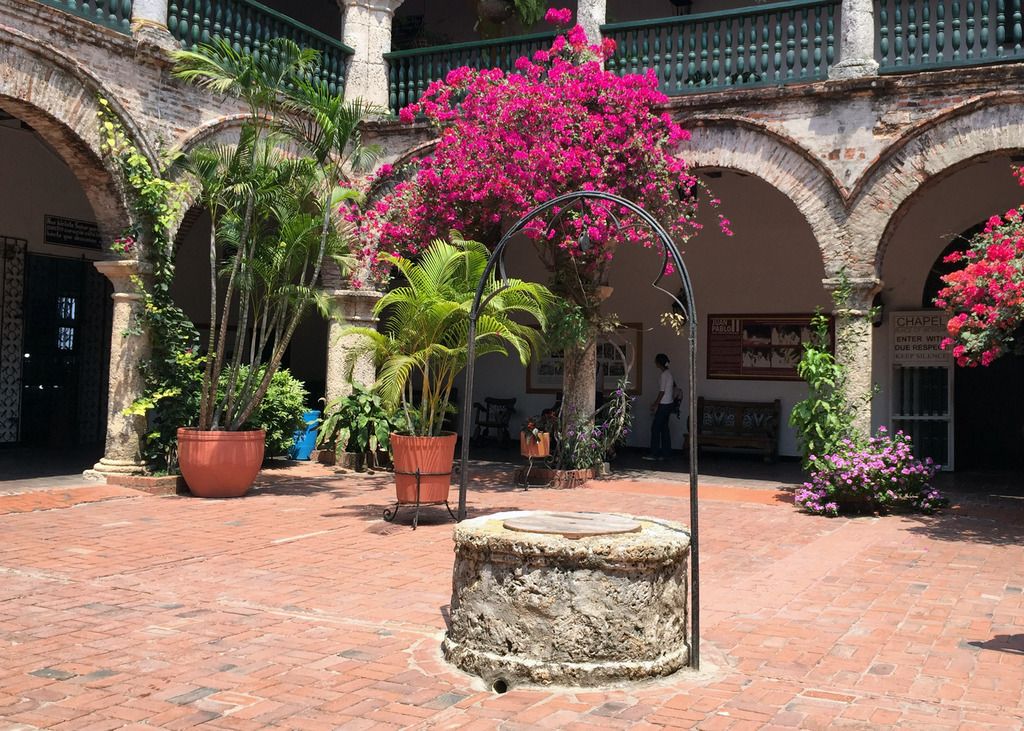
We could see both the old Castillo (in the middle of the photo) and the new skyscrapers from the convent's outdoor terrace.
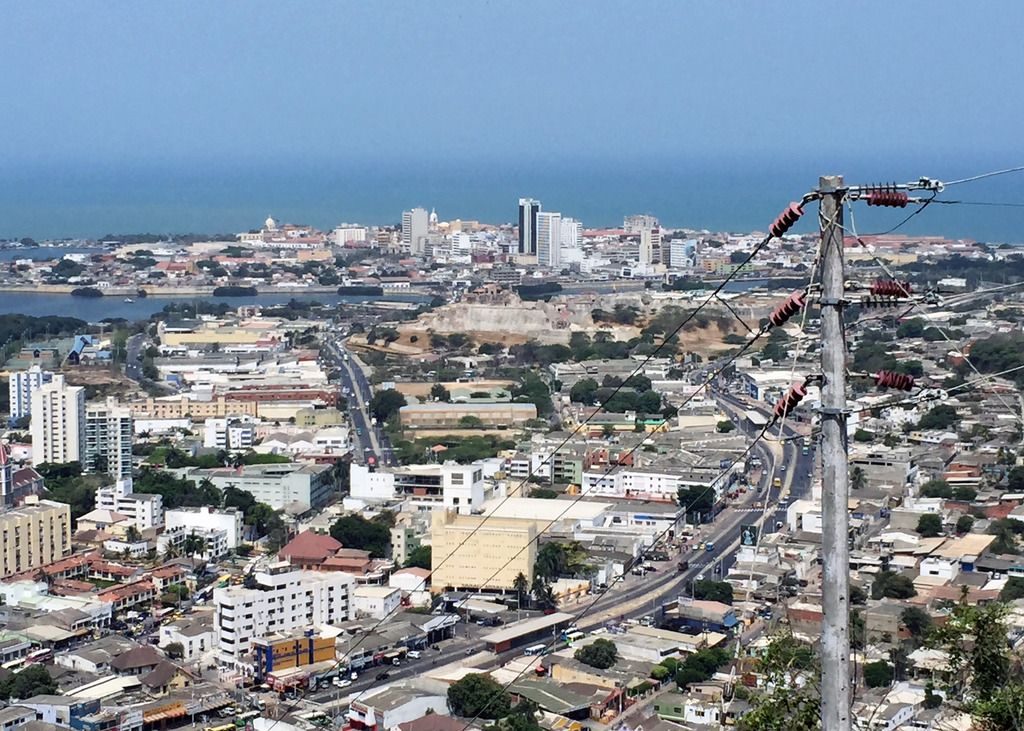
We could also see Cartagena's busy commercial port. The Celebrity Infinity and a Princess ship (the Coral Princess, maybe?) are also visible. The Infinity is to the left of the Princess ship.

-
The next morning we arrived in Cartagena. For this port I had chosen to sponsor a private tour for some of my fellow roll call members. Shortly before the Infinity arrived in port, I headed down to the usual spot in the Lounge on Deck 4 to meet our group. Everyone was on time and prepared for the day. We quickly disembarked the ship and after a short walk down the pier, located the representative for our tour company.
Our tour provider was Tour in Cartagena and my point of contact was Marelvy Peña-Hall. After contacting several companies, I had chosen Marelvy’s because she seemed to be the most willing to work with me to customize the tour to my preferences.
We followed the representative through the port terminal building and met our guide outside the port. Ester, our guide, was a native of Cartagena. It was easy to see that she loved her city and was proud of it. We climbed into the van. It was roomy and very clean, and the air-conditioning was heavenly. Ester introduced us to Edgar, our driver, and we were off.
Our first stop was the Castillo San Felipe Barajas, a fort built by the Spanish in the colonial period.
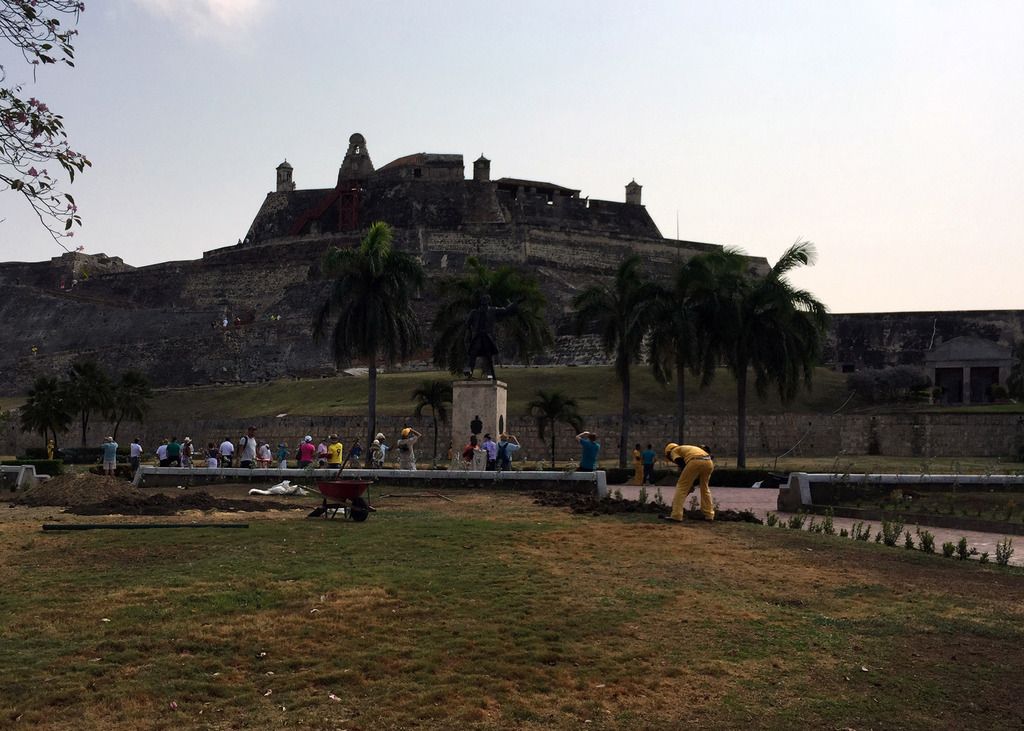
I had arranged for our tour to enter the Castillo. Ester obtained our tickets and we started the climb up the hill.
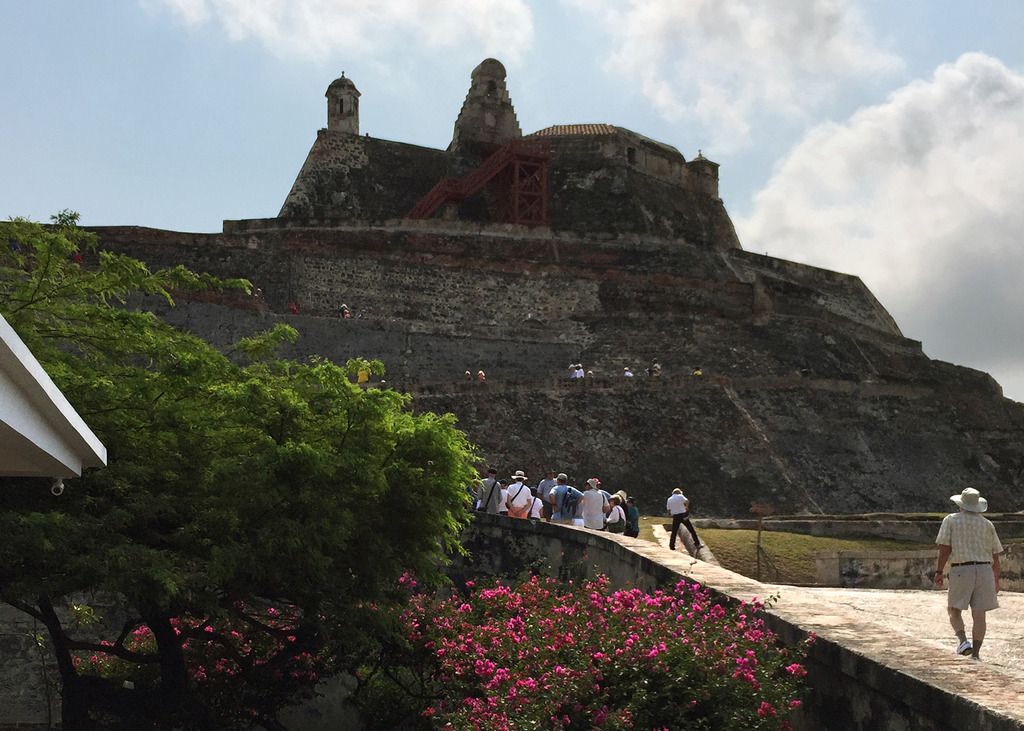
The uphill climb was not terribly difficult. We would walk up for several minutes and then Ester would stop us to point out something interesting in the fort’s construction or in the city below. When we reached the gate in the photo (below), Ester handed in our tickets and we continued to climb.
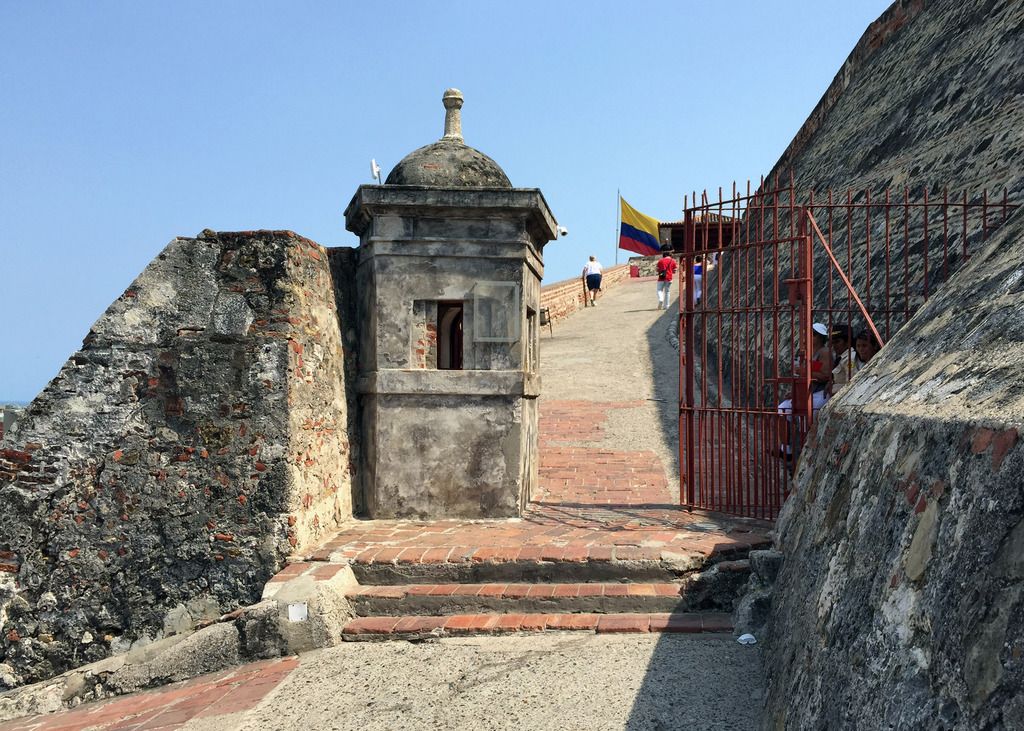
Ester provided a very interesting commentary on the fort, including its construction, restoration, and status as a UNESCO World Heritage Site. I loved this view of the old fort walls with the new white skyscrapers in the distance.
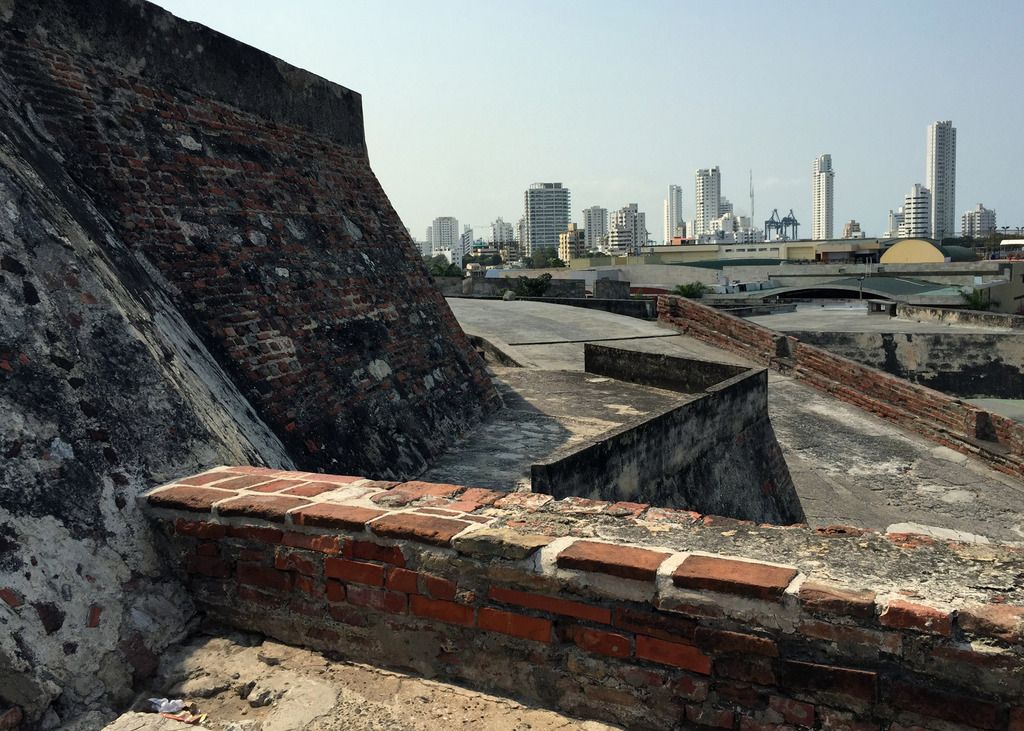
We began to see some very nice views, including the old city walls. If you’ll look along the street at the base of the hill, you’ll see several large tour buses lined up. Not all of the tours included entry into the fort; many just included a short stop with commentary at the foot of the hill.
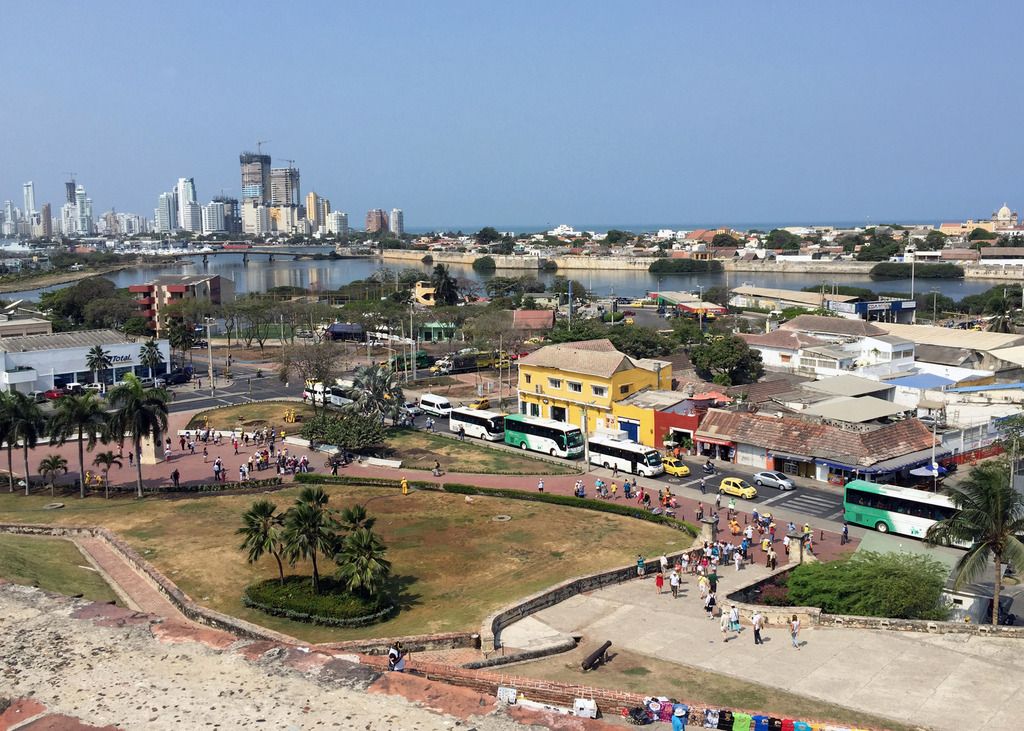
-
Some final thoughts on our two days in Panama. . . .
The Panama Canal, coupled with the port call in Colon the following day, made for two very interesting two days. We were able to see our oceangoing cruise ship lifted up and over a continent and then follow up the next day with a shore excursion that showed us lock operations from a different perspective.
There had been other private tours organized through our roll call. One roll call member said that he had really enjoyed his private excursion to the Embera Indian village.
Colon is another one of those ports where it would be best to have an organized activity planned ahead of time. The cruise terminal itself contains a nice assortment of shops and services but the neighborhood surrounding the terminal looked pretty rough.
The Path Between The Seas by David McCullough provides a thorough, detailed history of the building of the Panama Canal. (ComputerTravelGuy listened to the audio version on his daily commute.) The American Experience (a series on PBS) has a 90-minute episode on the Panama Canal that can be viewed online. There are also a lot of interesting resources and links on the PBS page. Click here to go to the American Experience's Panama Canal webpage.
We had originally chosen our cabin hoping that the window overlooking the bow would come in handy during our Panama Canal transit. As things turned out, it had been useful (and fun) to sit in air-conditioned comfort while watching the ship enter the locks, but most of the time, but we found that we spent most of that day moving around the ship as the scenery changed. The cabin had other attractions; it was roomy and very quiet. Being located on the bow, we felt the ship’s movement (which we enjoyed) in the cabin more than elsewhere on the ship. On the other hand, we felt a strong vibration whenever the bow thrusters were used. So if all of these characteristics together sound good, this cabin might be a good choice for a Panama Canal itinerary; if you don't like movement or you don't relish the thought of the bow thrusters as an early wake-up call, another cabin might be a better choice.
-
Before I finish up my discussion on our two days in Panama, I thought it might be fun to pause and share a few photos from an earlier visit to the Canal in 2011. I’ll resume the discussion our 2015 transit with the next post.
These photos were taken during a shore excursion when we visited the Panama Canal during early December, 2011. After leaving the ship, we were transferred via tour bus to a small passenger ferry that entered the Canal at the north end of the Culebra Cut. We passed through the Culebra Cut, the Pedro Miguel locks, Miraflores Lake, and the Miraflores locks before reaching the Pacific Ocean. As you can see, transiting the locks in a small passenger ferry was an entirely different experience than it was on a Panamax-sized cruise ship.
Our small passenger ferry has just been lowered in the Pedro Miguel locks. This photo was taken from the stern looking back toward the Centennial Bridge.
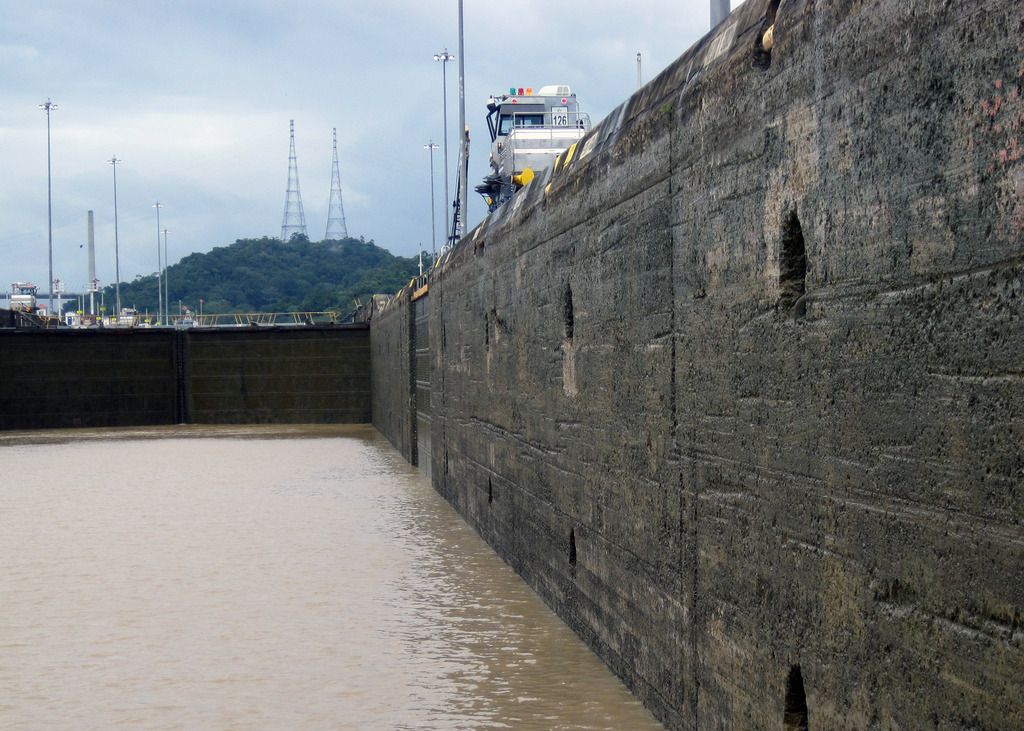
Another view of the wall.
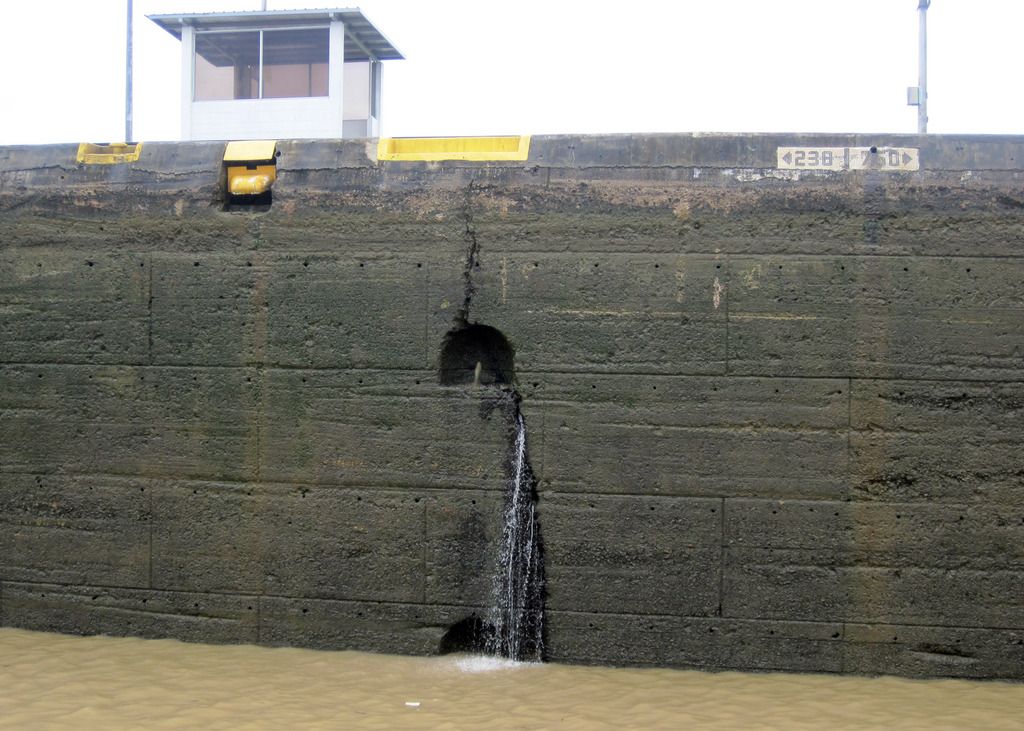
The lock gates have opened and we are preparing to exit the chamber.
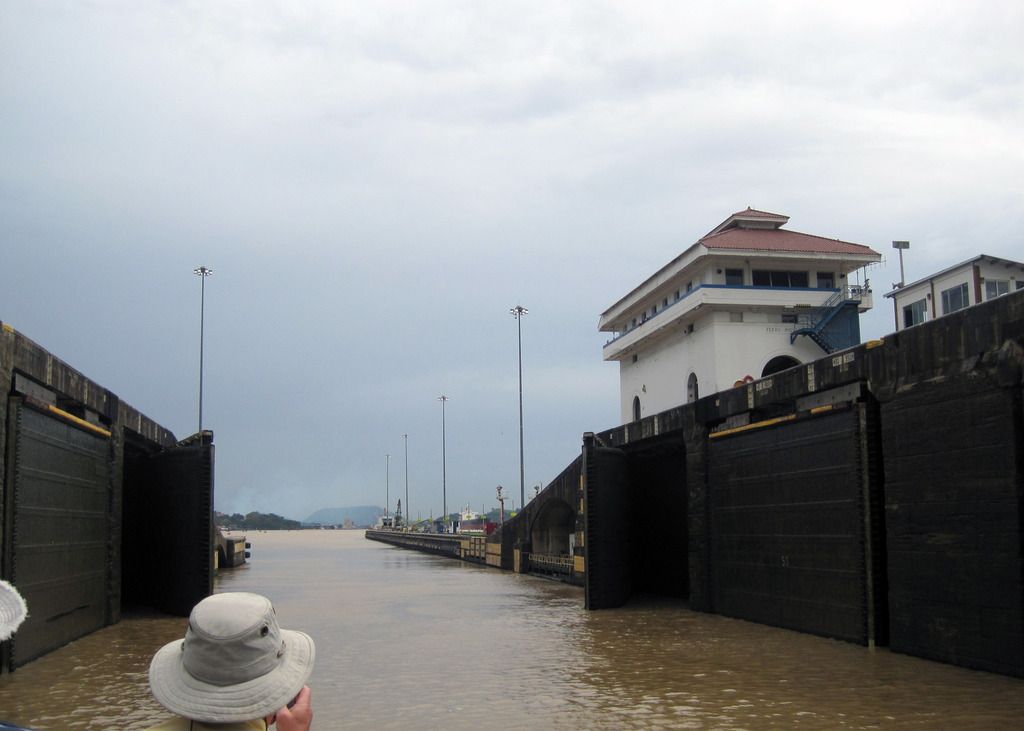
The next two photos show lock gates opening.
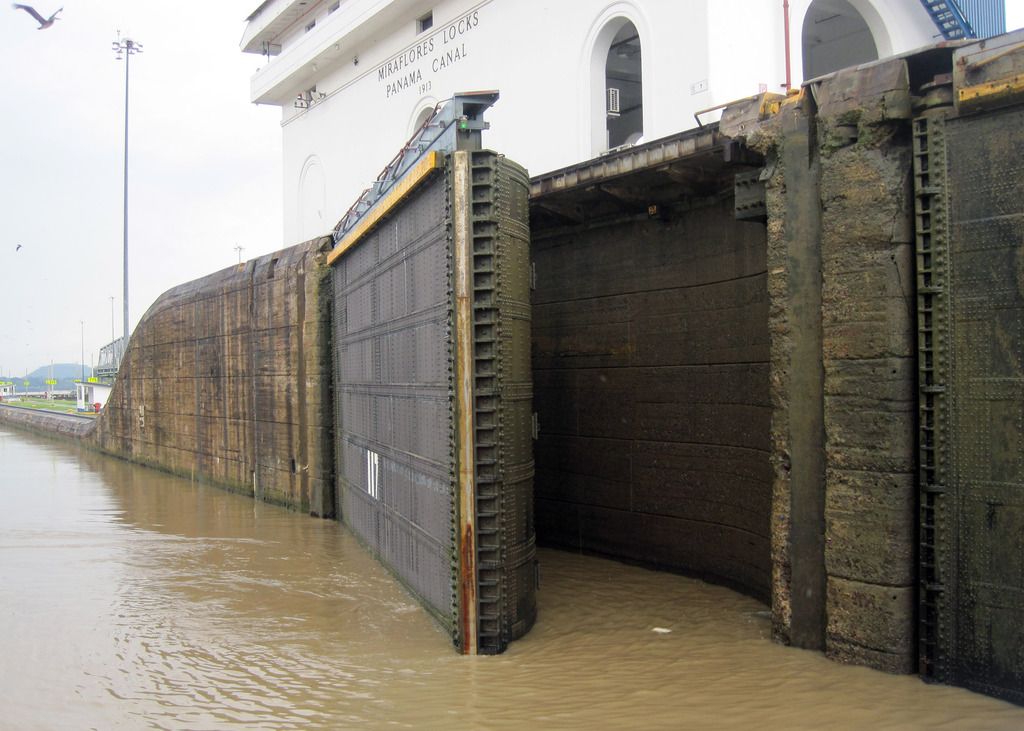
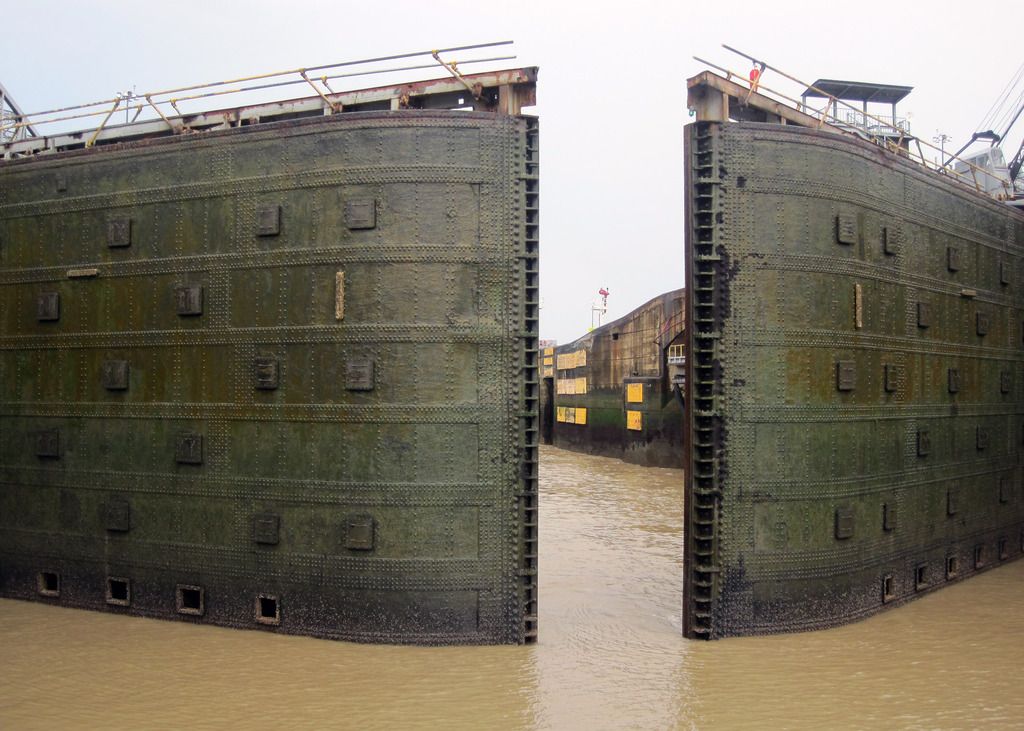
A container ship towers over our little passenger ferry as it passes under the Bridge of the Americas.
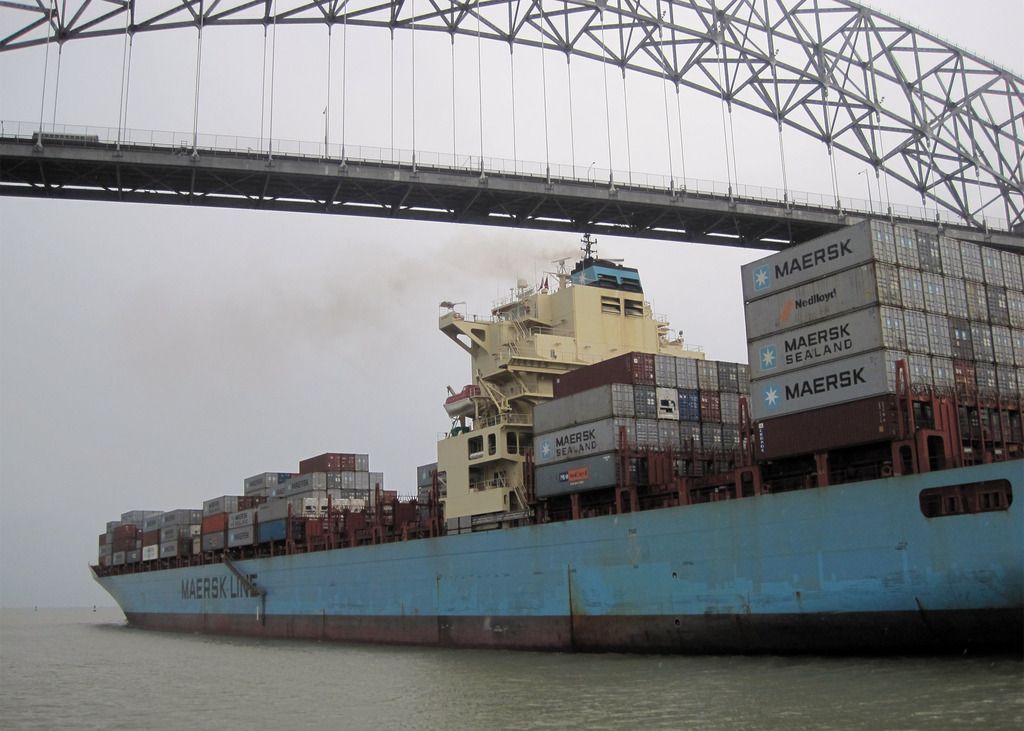
-
Sorry for my ignorance and I tried to google this ... but what's the story behind the hundreds of lives lost?
Hi, aSiAnRiCk, Most of the deaths in the Culebra Cut were caused by landslides and the mishandling of dynamite. J-D has provided a link to an article that provides more details about the terrible death toll during the Canal's construction.
Here is an overview of the horrendous death toll during the overall construction effort -- both French and American phases:https://thesilverpeopleheritage.wordpress.com/2008/12/17/the-panama-canal-death-tolls/
Thanks for providing the link to this article. I found it to be interesting and sobering.
-
Later that evening I opened my laptop to transfer my photos from my camera to my laptop. It had been my practice to transfer the images after every port call and evaluate them while the day was still fresh in my mind. I hadn’t had time to transfer the images from the previous day’s photos of the Panama Canal transit so I was looking forward to seeing them as well.
I connected my little Canon to my computer and was surprised to see an error message on the camera’s display. I unplugged, cleaned, and reseated all the connectors and still got the same error. When ComputerTravelGuy came back to the cabin, I gave him the news. We talked it over and decided to take the chip down to the Photo Department to ask them transfer the files from the camera’s chip to a disc. Two days later, the disc was ready. Since we only needed the last two days of images, everything fit on one disc.
-
After watching Canal operations for a while, we reluctantly made our way down the stairs. Everyone took turns getting their photos taken in the cabs of the old mules. After a quick pass through the small gift shop, we walked outside in time to see Janet pulling up in the van.
Our next stop was the Panama Canal Expansion Observation Center. The previous day we had seen the Observation Center from the ship as we had approached the Gatun Locks. In the photo you can see it high on the hill above the ship. The bow of the Azamara Journey can also be seen on the right of the photo.
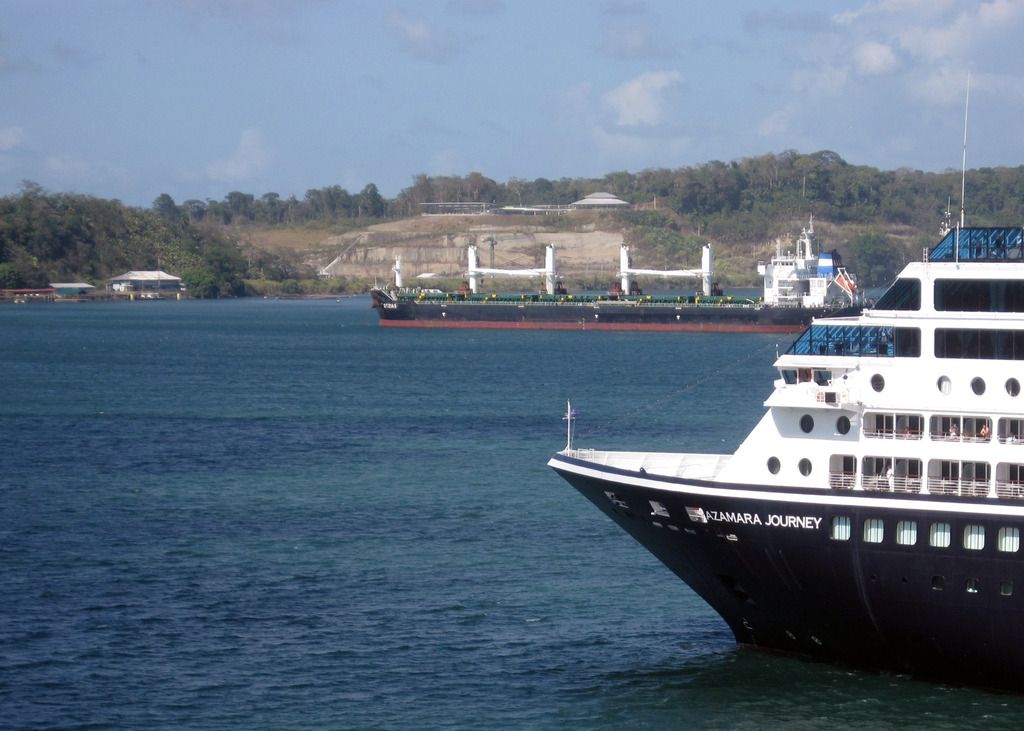
The Observation Center was a brand new, beautiful facility well-situated on its hilltop. From the covered observation area, we could see for miles. If we looked in one direction we saw the Caribbean; in the other direction was Gatun Lake. What caught our attention, however, was the massive construction project at our feet. Most of us had attended the Infinity's lecture series on the Canal, but there was no way that the photos and statistics in the PowerPoint presentations could have adequately prepared us for what we were seeing. It was enormous!
The massive rolling gates can be seen below.
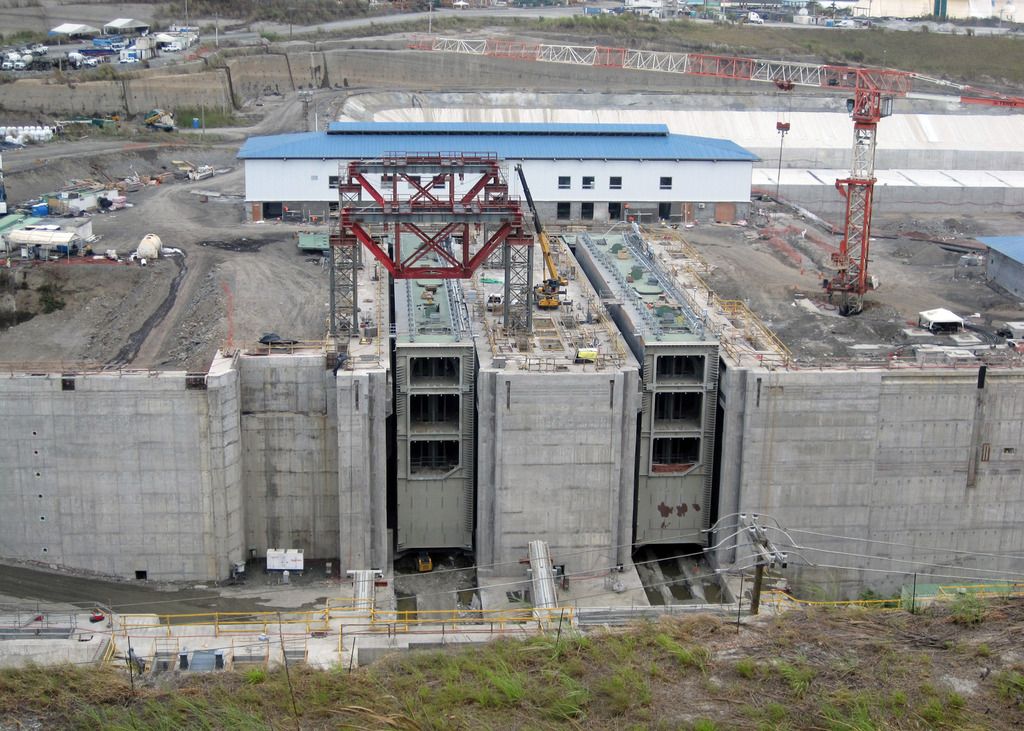
This photo shows one wall of the new locks. The Caribbean is visible in the upper right of the photo. If you look closely you can see a couple of pickup trucks parked next to the wall near the building with the blue roof. This will give you some idea of the scale of the project.
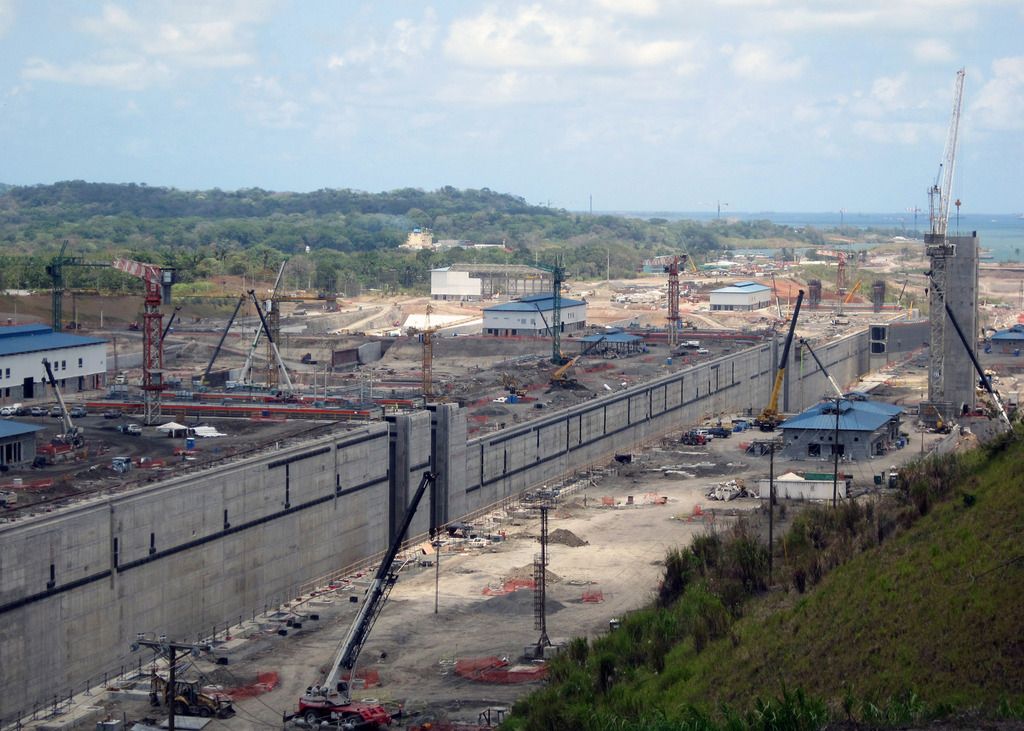
Looking toward Gatun Lake
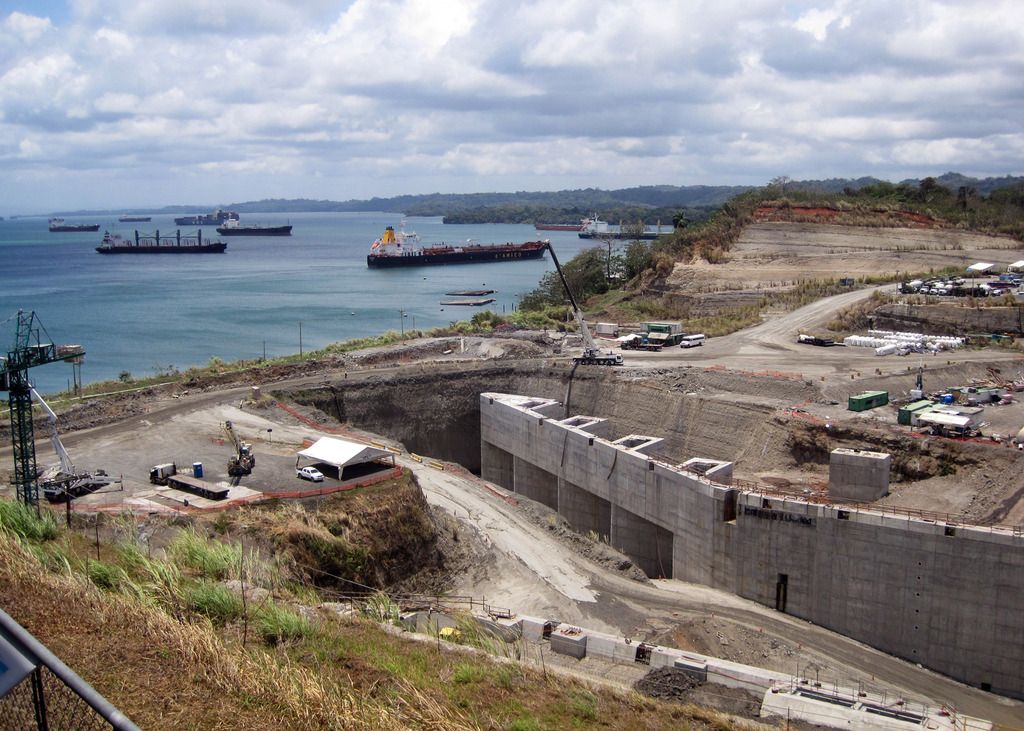
After leaving the Observation Center, we made our way back to the port. We thanked Reynaldo and Janet for the great day and made our way through the shops in the terminal back to the ship. Infinity crew members welcomed us back with chilled towels and cold water.
-
After leaving the fort, we made our way toward our next stop, the Gatun Visitor Center. While we were crossing the swing bridge in front of the Gatun Locks, ComputerTravelGuy snapped this photo of the lock gates.
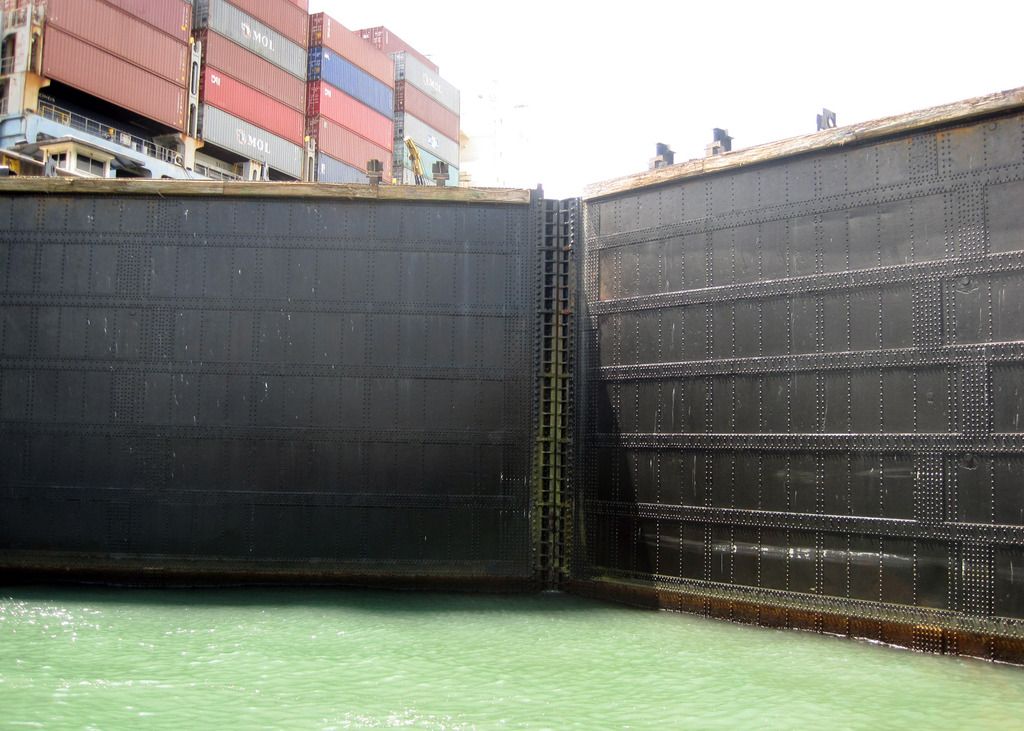
Just inside the entrance, we saw these historic old mules.
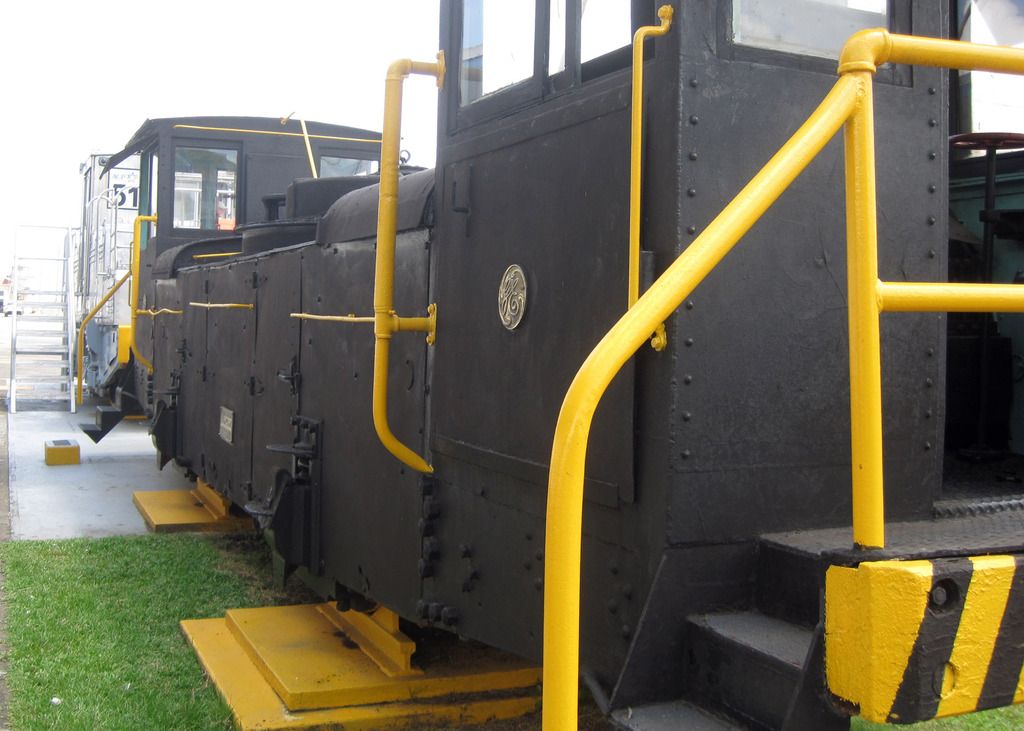
We climbed up (and up and up) a very long flight of stairs and found ourselves on a covered, open-air platform. We had the perfect view from which to observe Canal operations.
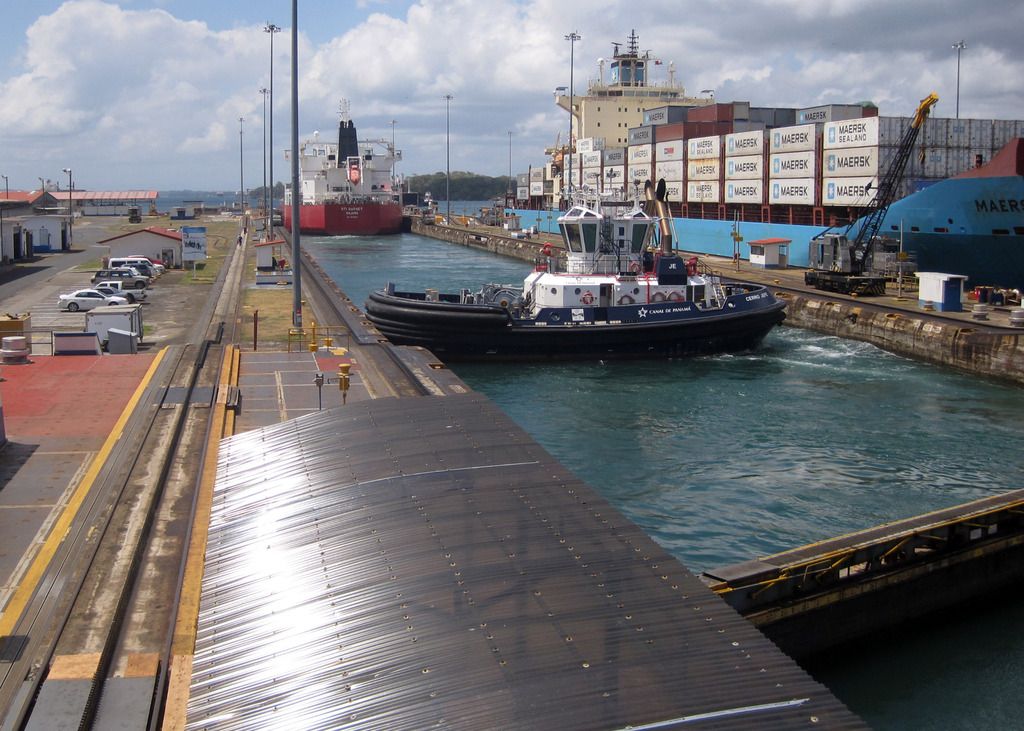
Note how close the bow of this ship is to the lock gates. We were surprised by how quickly water filled the chamber.
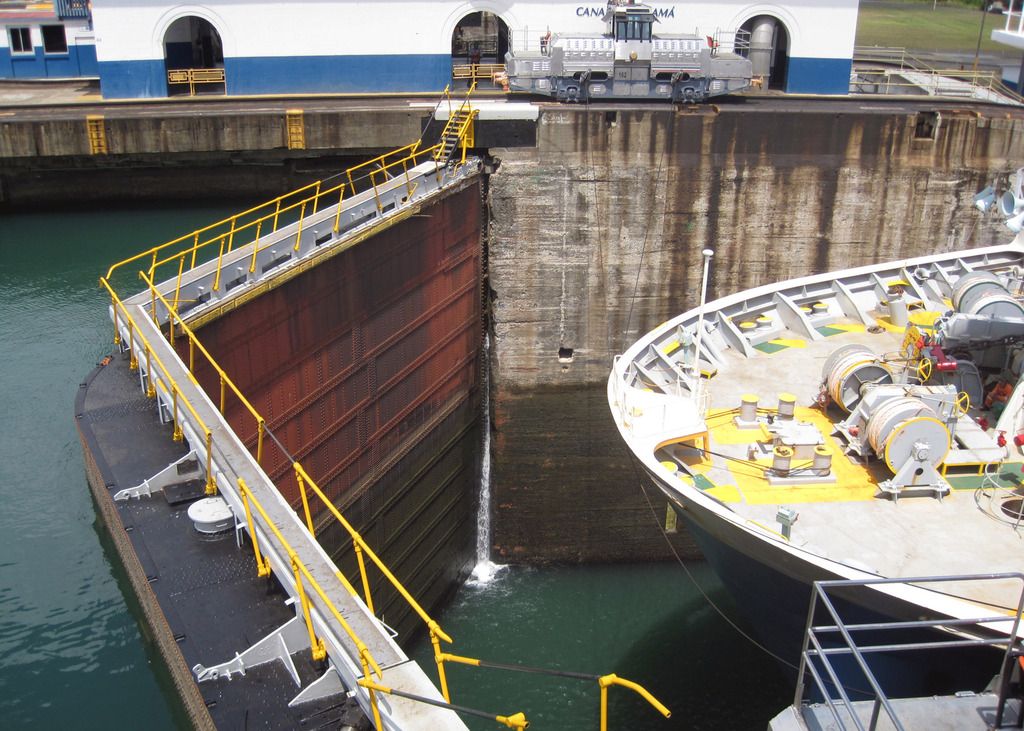
This photo gives some idea of just how big the current mules are. Compare the size of the mule with the human-sized stairs.
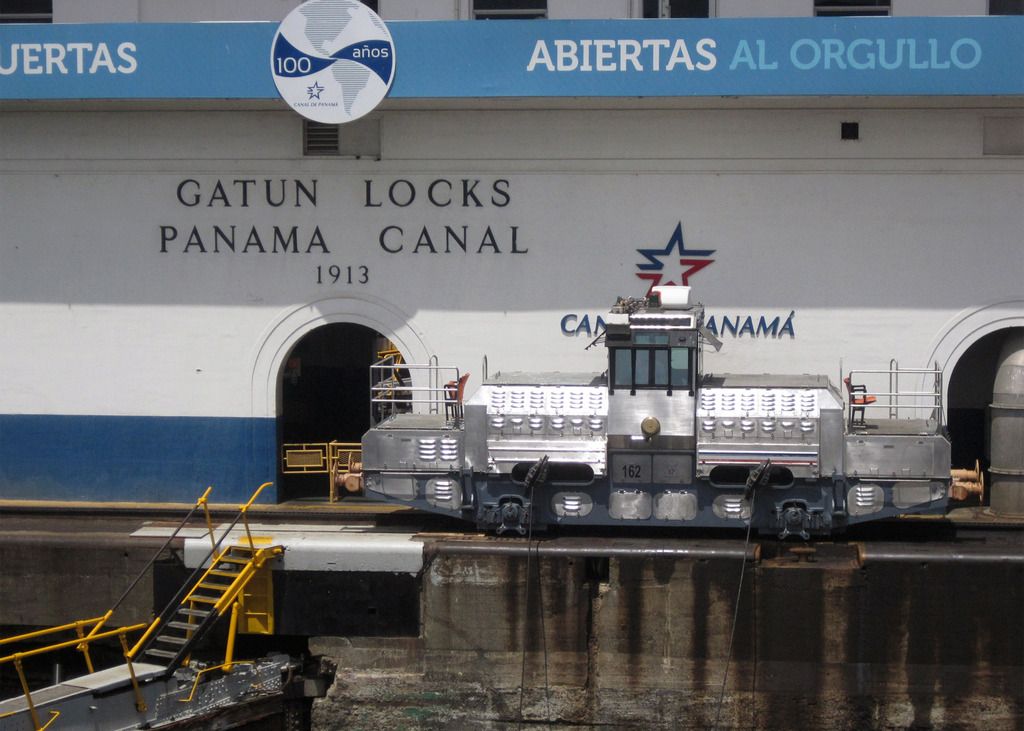
-
Fort San Lorenzo was built in 1560 by the Spanish at the mouth of the Chagres River to protect the Las Cruces gold trail. The trail was used during the rainy-season to transport Peruvian gold from Panama City on the Pacific across the isthmus to where the Chagres River emptied into the Caribbean Sea. The fort was attacked by the Pirate Henry Morgan in 1670. Ten years later the Spanish built a new fort 24 meters (80 feet) above the water.
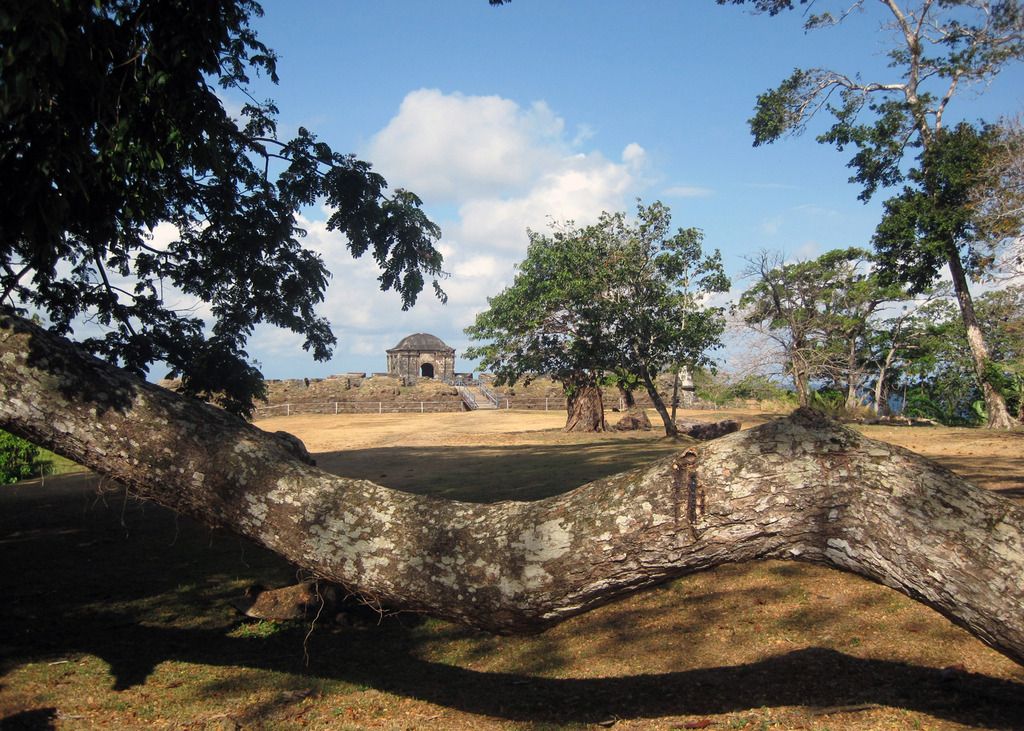
The fort’s battery
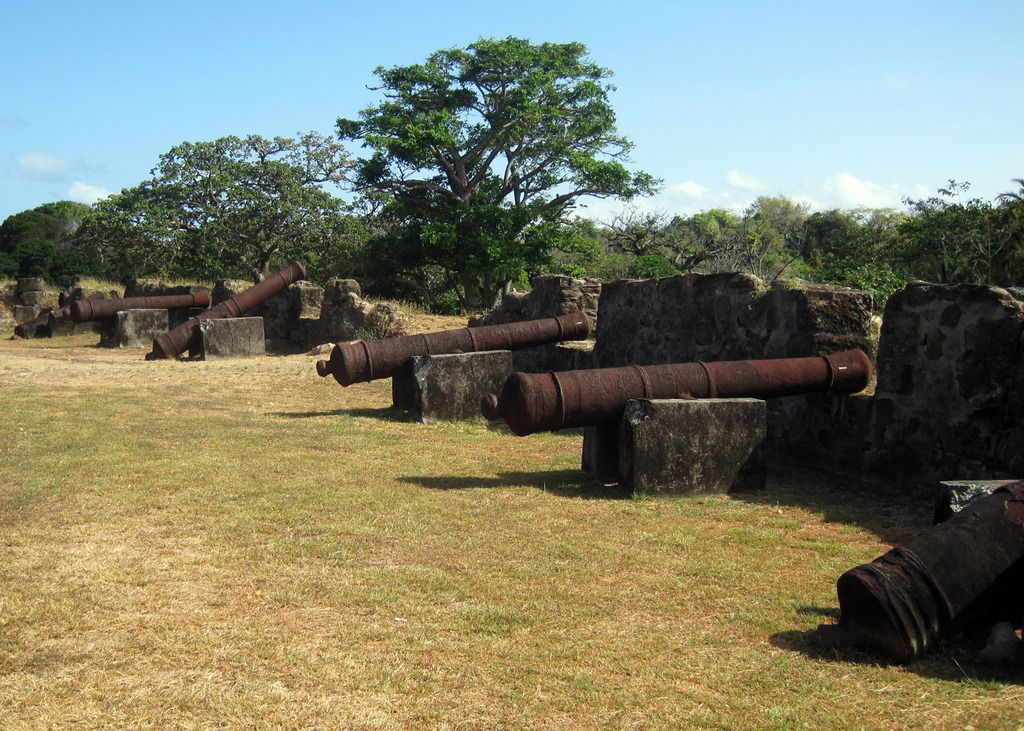
Another view of Fort San Lorenzo
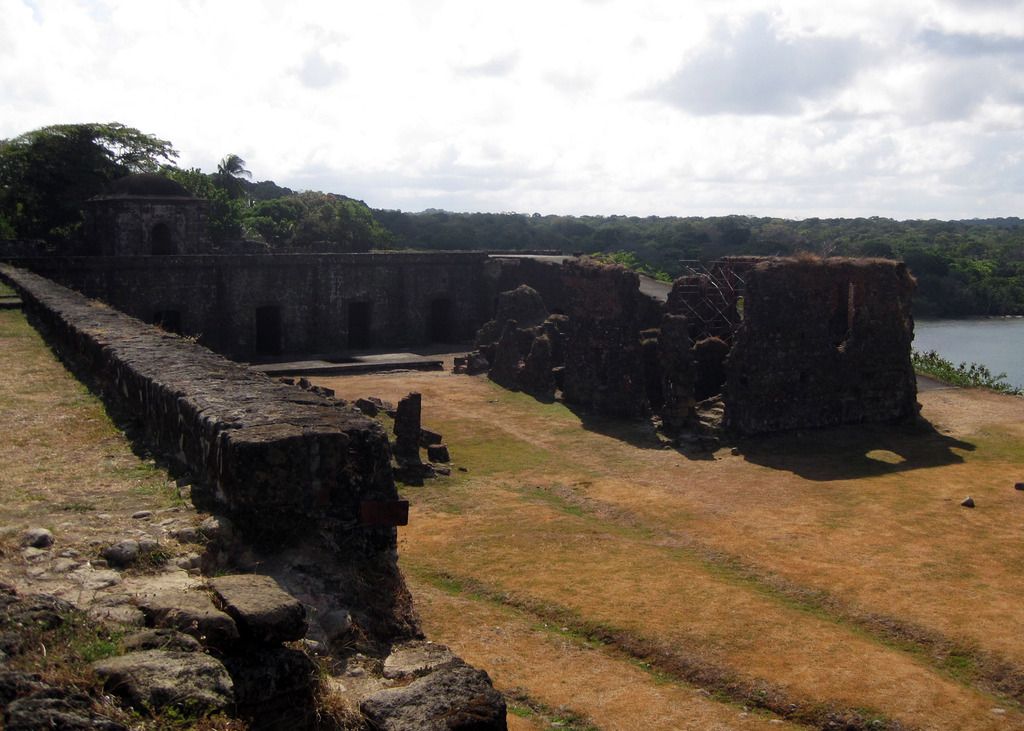
The Chagres River meeting the Caribbean Sea
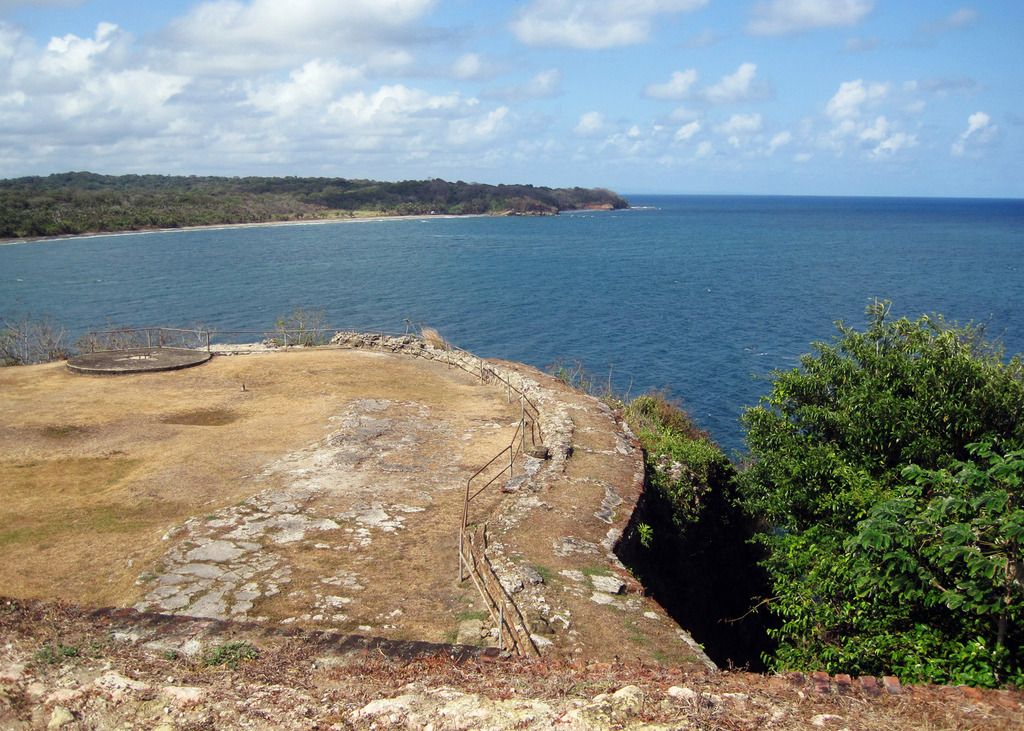
Looking up the Chagres River

-
The next morning we arrived in Colon, Panama at 7 AM. We awakened early, grabbed a quick bite to eat, and headed down to meet our tour group in the Rendez Vous Lounge. Another member of our roll call had arranged a tour through Robtad’s Tours. The stops included Fort San Lorenzo, the Gatun Visitor Center, and the Panama Canal Expansion Observation Center. We were all on time, so by 7:15 we were off the ship and on our way to meet our tour guide. Our guide was Reynaldo and our driver was Janet. The 15-passenger van had more than enough room for our seven tour members, plus our driver and guide.
Our first stop was to be the fort. Colon’s morning traffic was busy and chaotic, but Janet was up to the challenge. I sat back and admired her “artistry” while listening to Reynaldo’s narration. After 15-20 minutes we came to a dead stop. Reynaldo explained that we were lined up to cross the Panama Canal via the swing bridge at the Gatun Locks. After a few minutes, traffic started moving again and we crossed the Canal and continued on our way.
On our way to the fort, we couldn’t believe how thick and lush the jungle was. Reynaldo told us that this was Panama’s dry season, and in the rainy season, the jungle was even more dense.
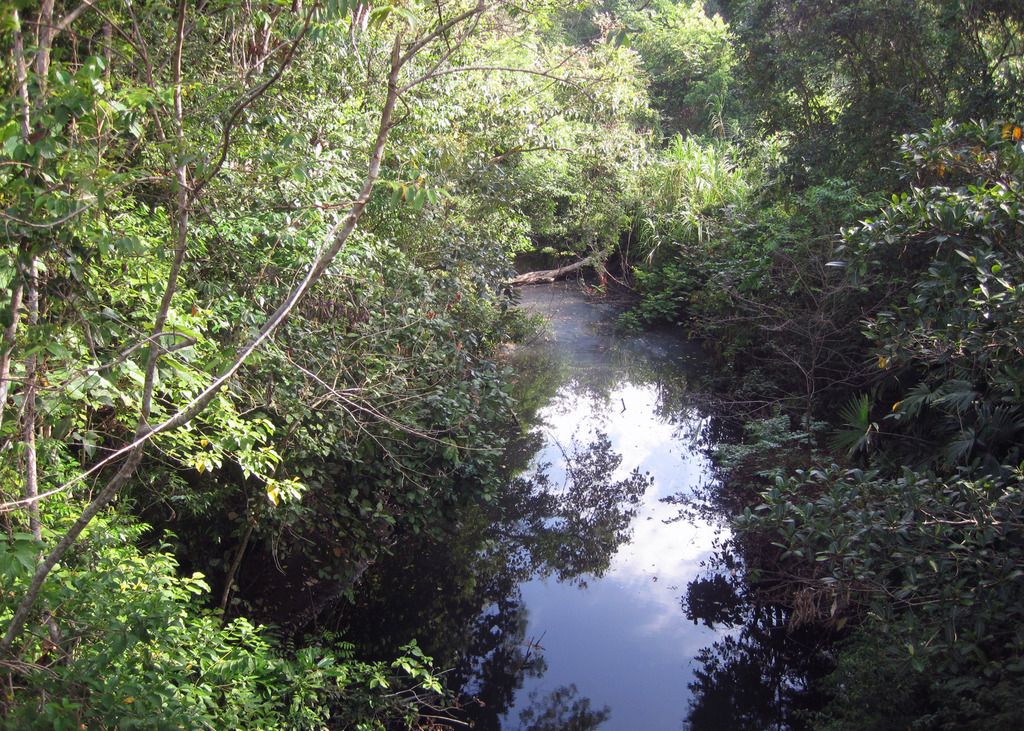
Arriving on the grounds of the fort, these hanging nests first attracted our attention.
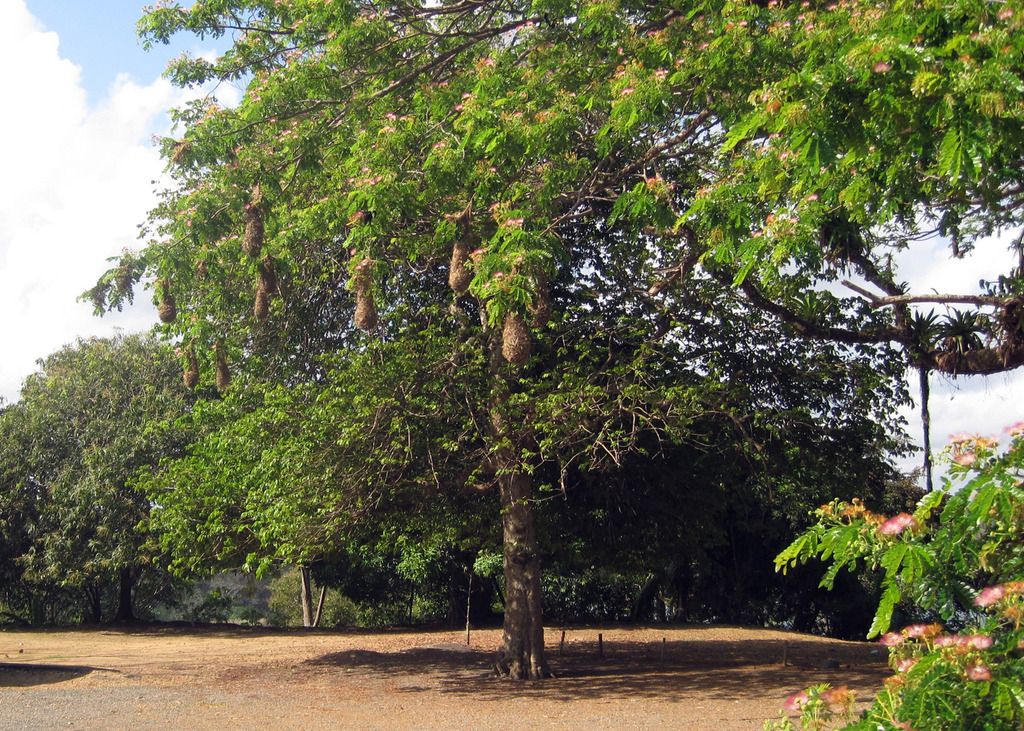
This is the bird responsible for building the nests in the above photo. According to my Panama bird book, it is some sort of oropendola.
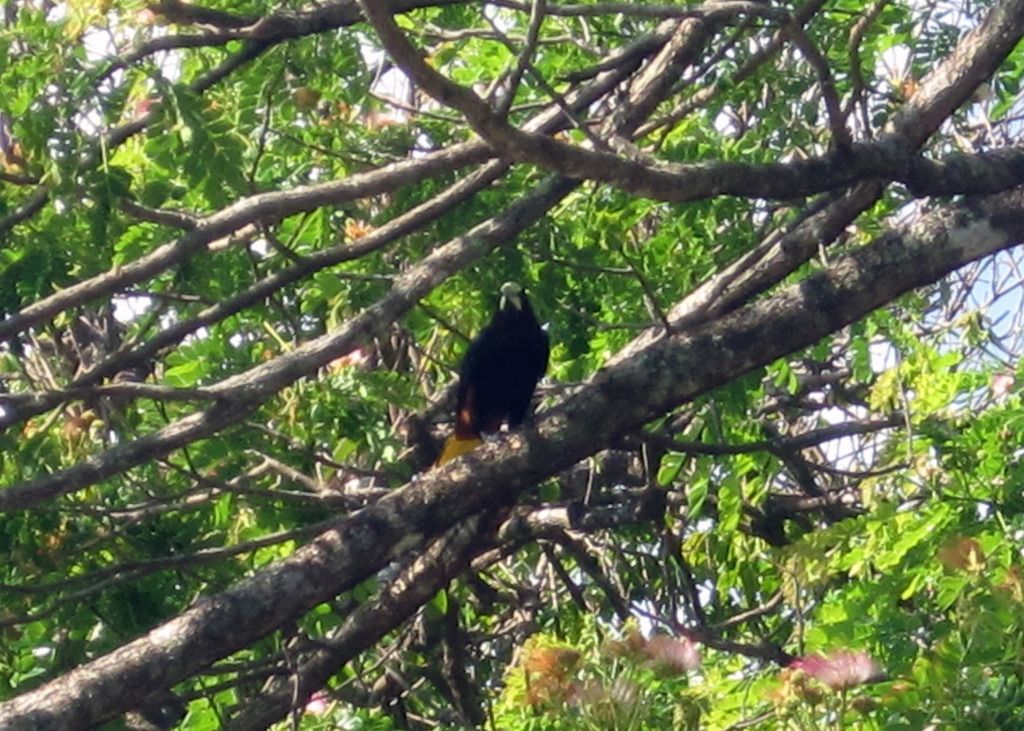
-
Amazing pictures. This is a cruise my DH and I are planning in the future. Can't wait to see what tomorrow brings!
Thank you! We have so many amazing photos from that day that it was hard to know what to post. I'll be adding the photos from our day in Colon shortly so, stay tuned. . . .
-
After the Infinity had entered the first chamber of the Gatun Locks, our friends invited us to join them at an open house being held in a stern cabin by a couple of roll call members. We left our cabin in the bow and traveled the length of the ship to the open house in the stern. We thanked our host and headed out to the balcony.
Seeing the locks from the stern provided us with an entirely different perspective. For much of the time, the lock walls were so close that we could have reached out and touched them.
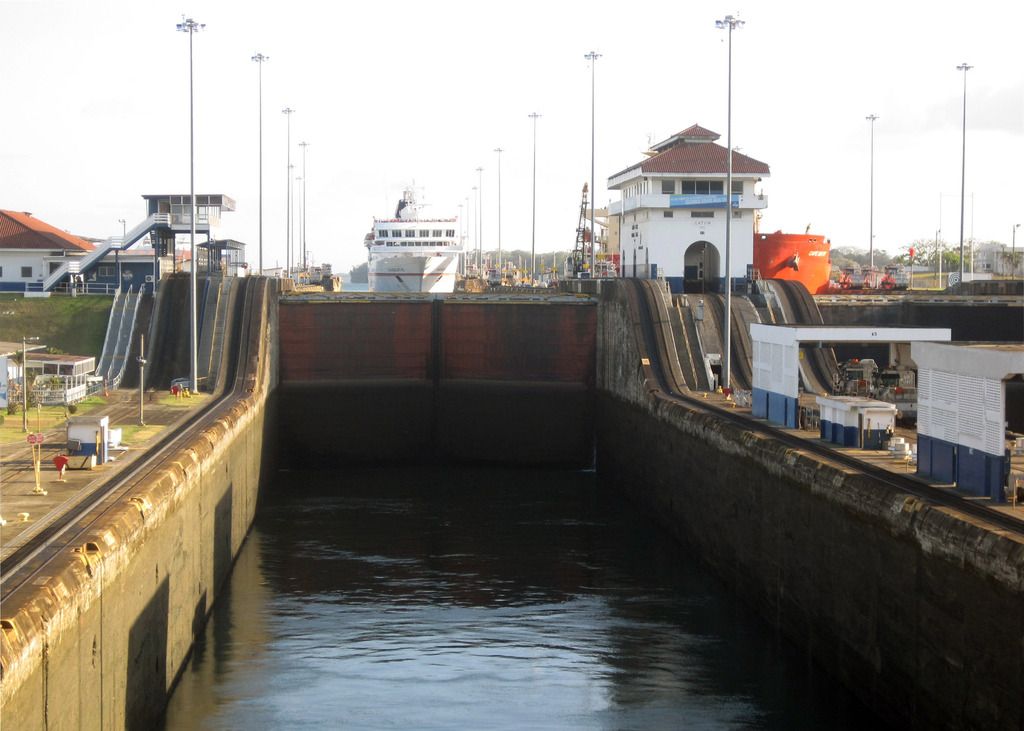
We smiled and waved at the mule driver who smiled right back at us.
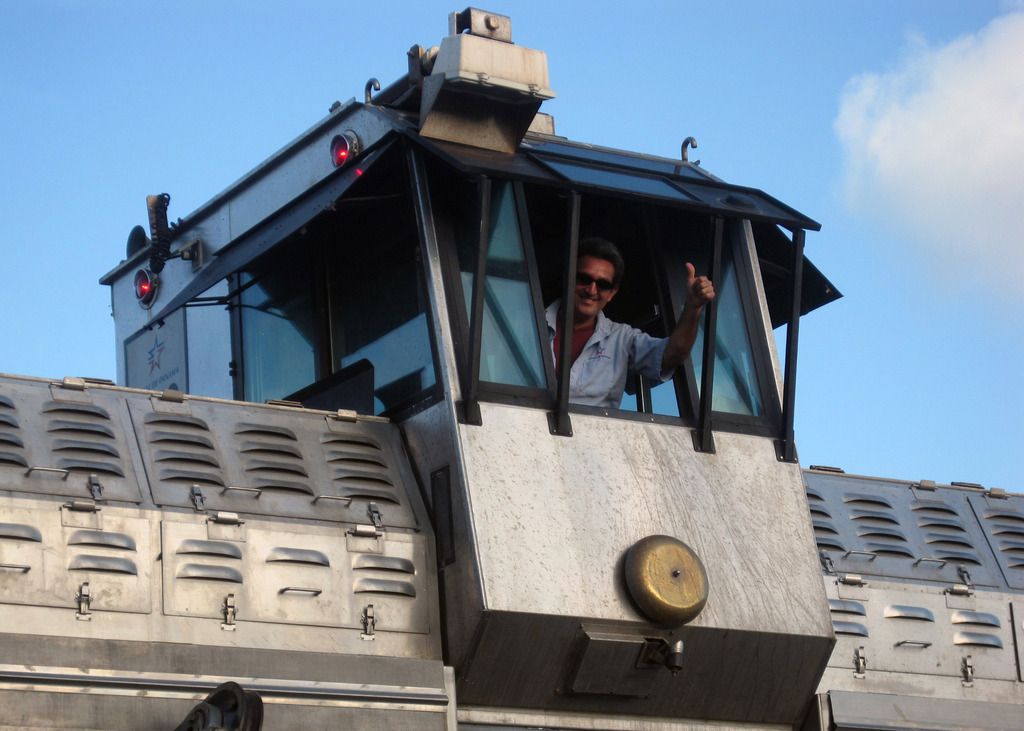
It seemed that almost no time had passed when we realized that we had been lowered to sea level and were pulling away.
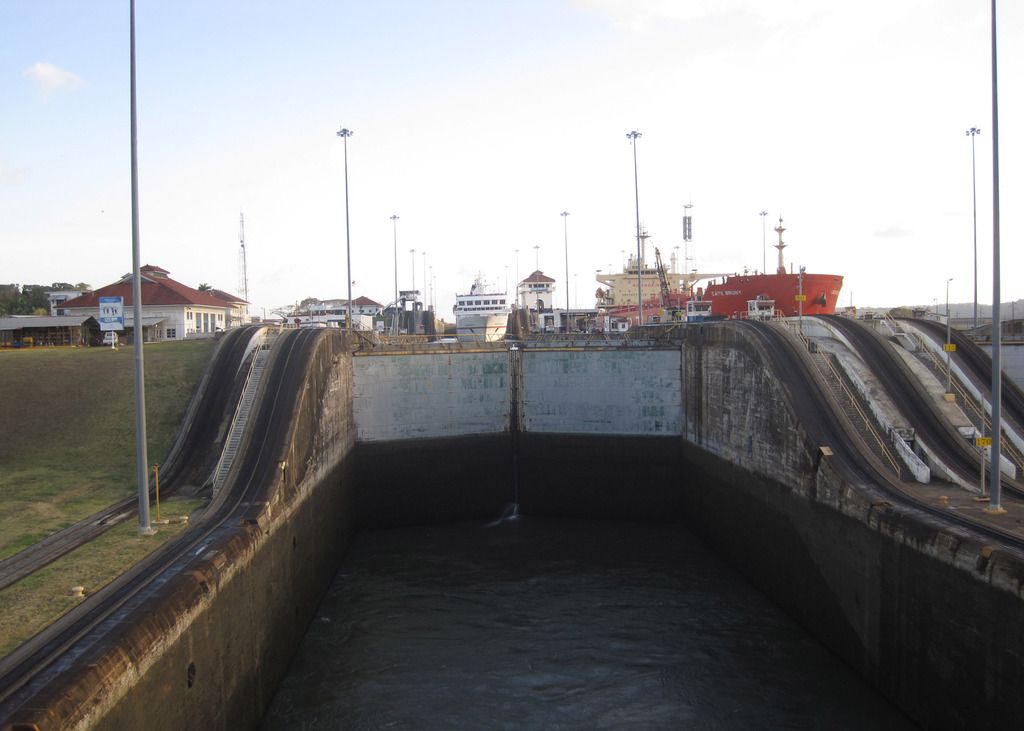
As we left the Gatun Locks behind, I pondered the day's events. We had just crossed a continent on an ocean-going cruise ship using technology that was over one hundred years old.

-
I met ComputerTravelGuy in the cabin and we headed down to the main dining room for lunch. We managed to get a table by the window where we watched the Culebra Cut pass by. We thought about the many hundreds of lives that had been lost where we were now cruising. It was sobering.
Later in the afternoon we joined friends on their balcony and watched Gatún Lake glide by. It was a beautiful, sunny afternoon with just a hint of a breeze.
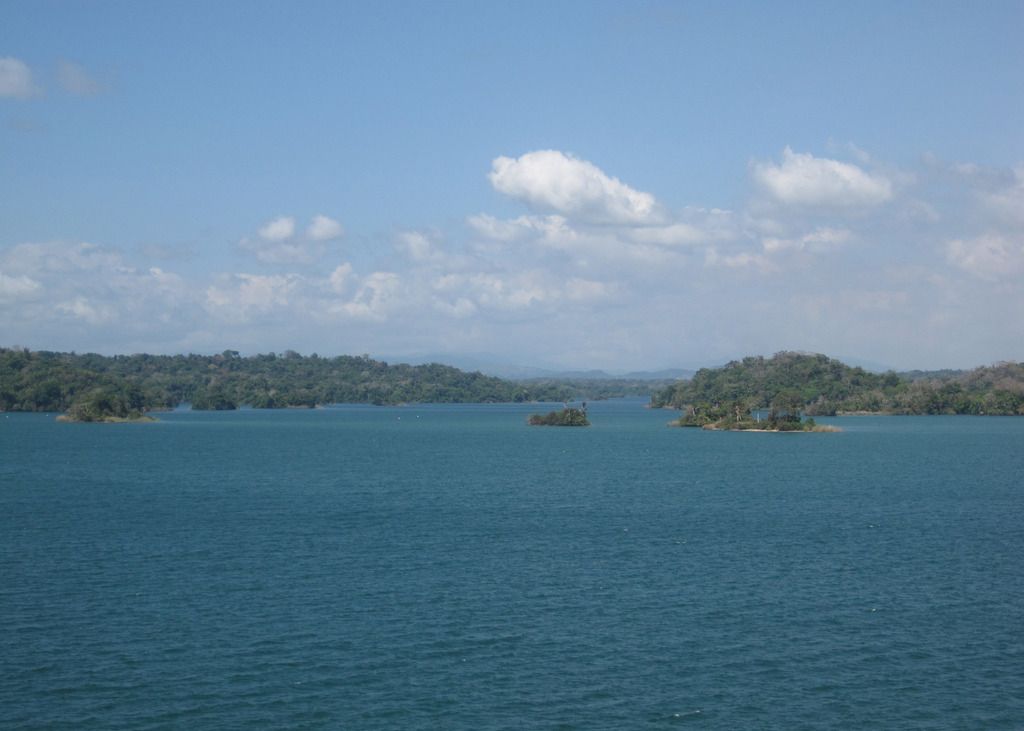
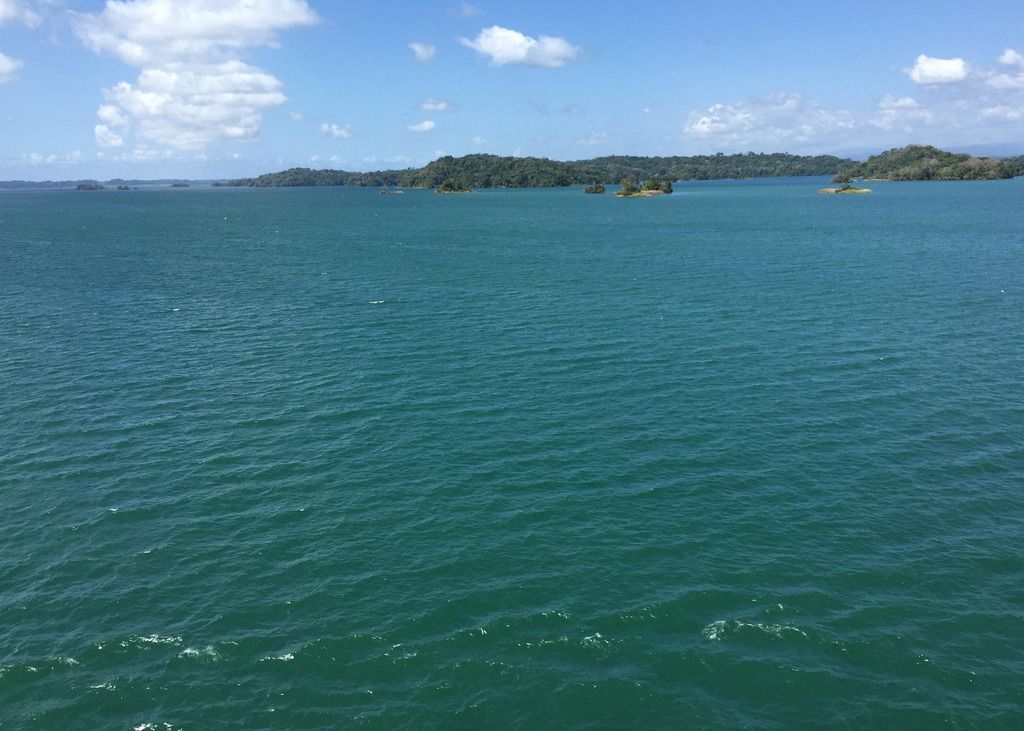
When we spotted the water towers in the distance, we knew that we were getting close to the Gatún Locks.
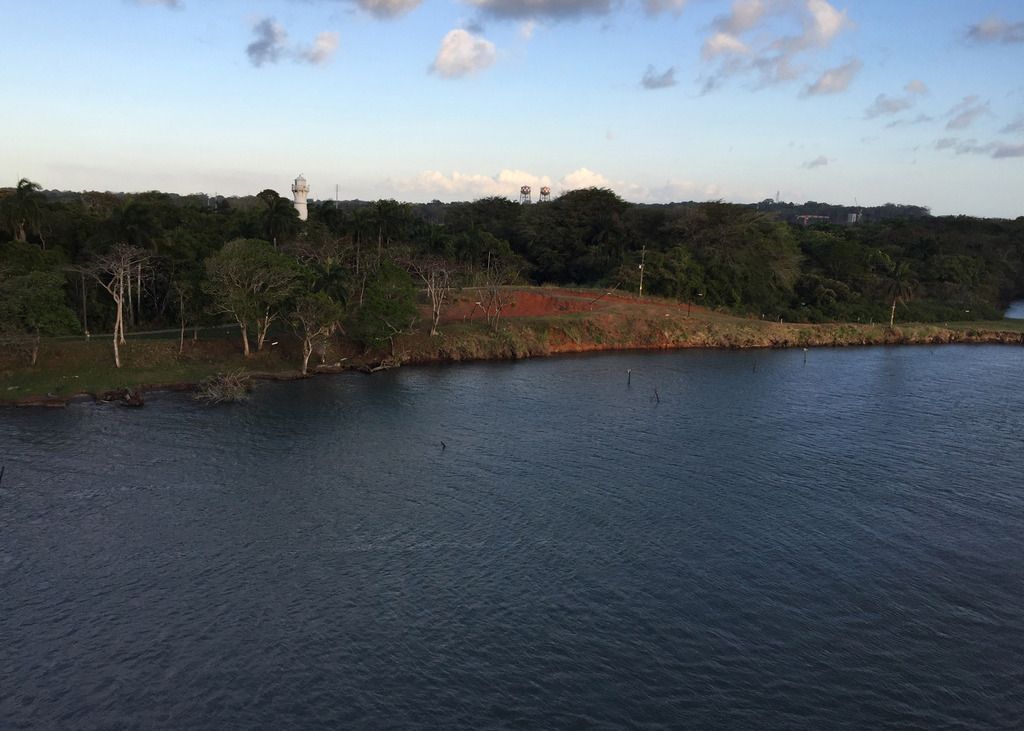
The four of us moved to our cabin in the bow to watch the Infinity enter the first chamber of the Gatun Locks.
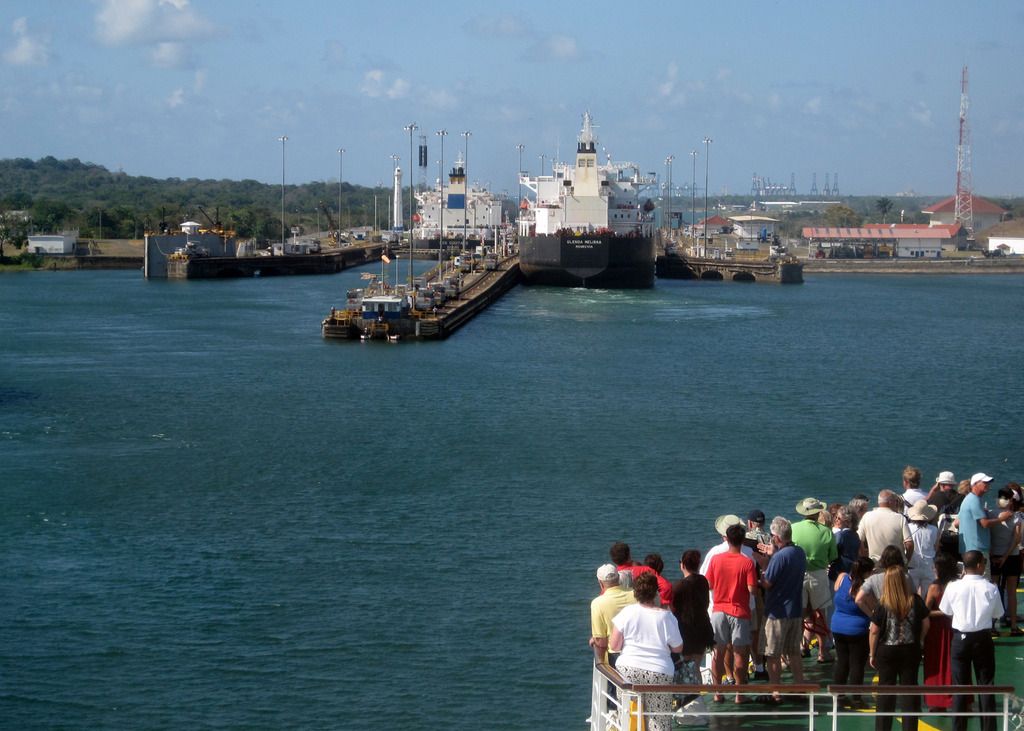
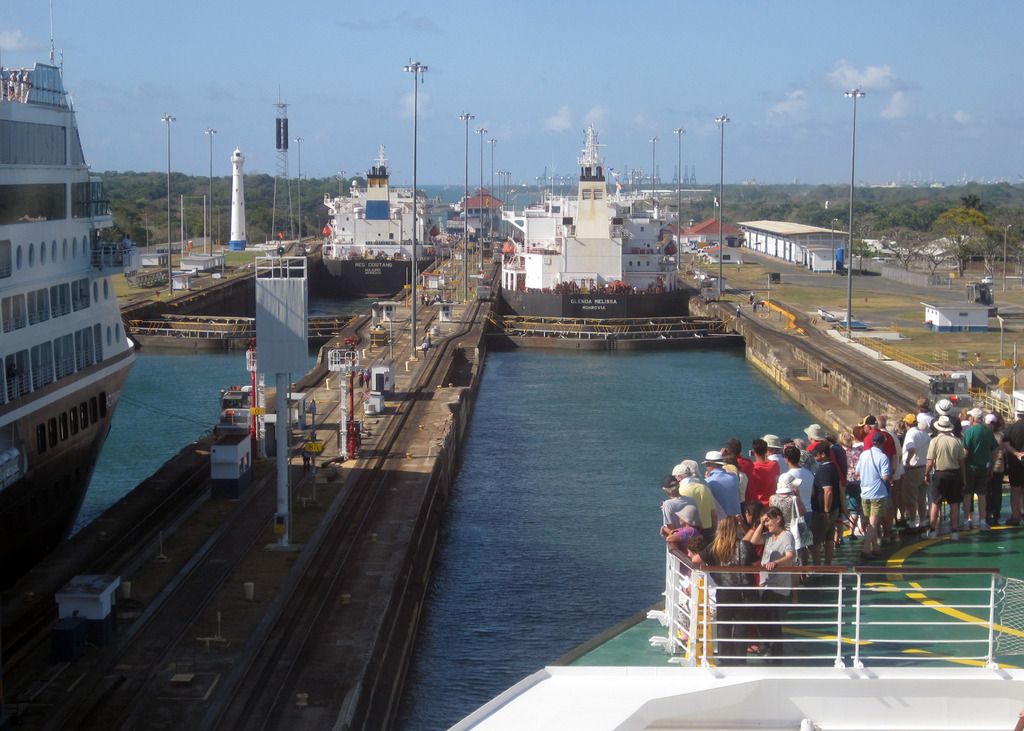
-
We passed under the Bridge of the Americas and proceeded toward the Miraflores Locks.

As we entered the first chamber of the Miraflores Locks, I could see passengers standing on the bow. I decided to head down there. I kept asking questions until eventually I was directed to the balcony of the Celebrity theater. I walked through the balcony and found a door to the outside. A Celebrity staff member was available to assist passengers with the step over the threshold. Passengers were checked for proper footwear (i. e., no flip flops) before being allowed outside on the bow. Once outside I made my way up a flight of steps and to the front. I could see two ships rising in the locks ahead of us.
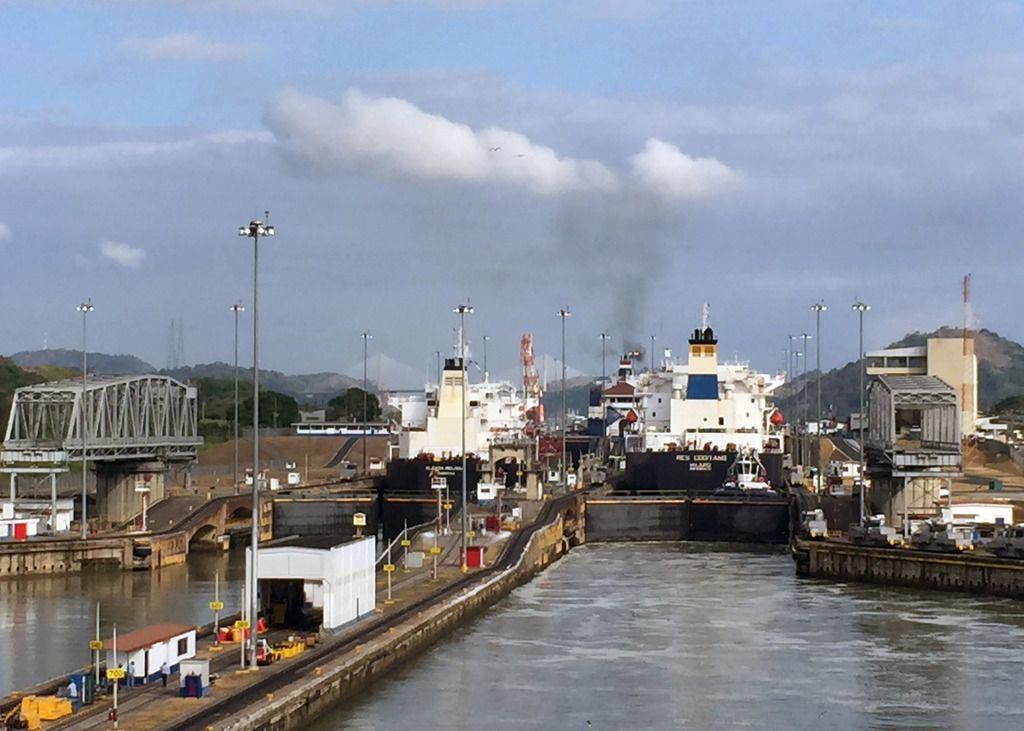
ComputerTravelGuy stayed upstairs to capture the transit from a different perspective.
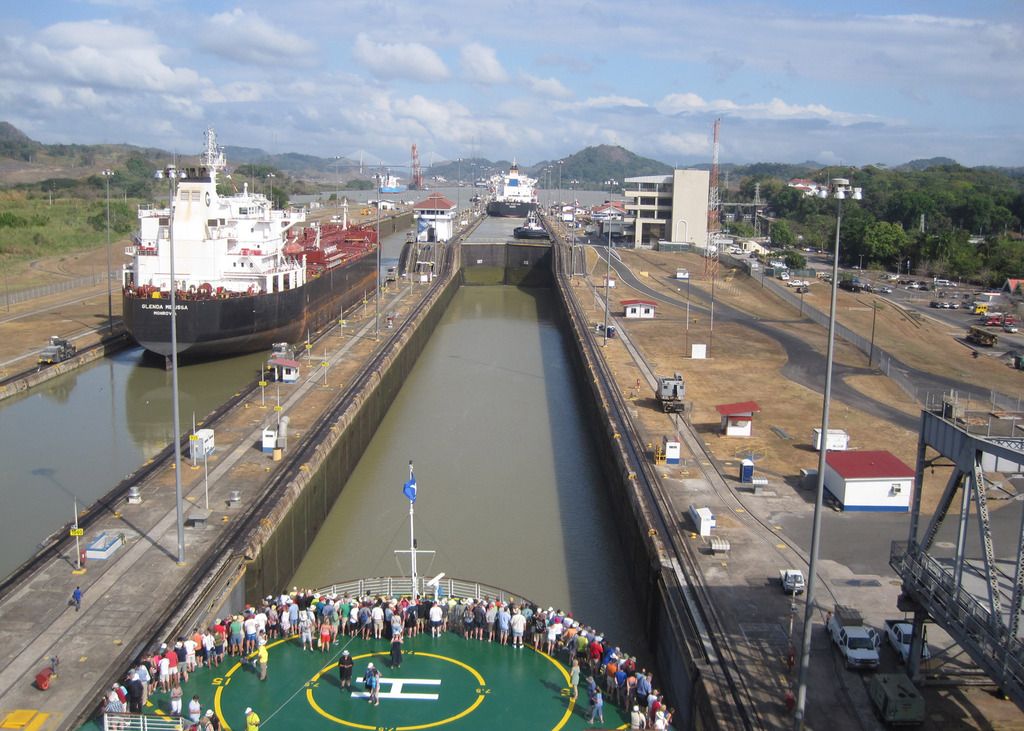
By the time I took this photo, the Infinity had entered the next chamber of the Miraflores Locks. The two ships ahead of us had crossed Miraflores Lake and were now in the the Pedro Miguel Locks. The Centennial Bridge can be seen in the distance.

We were just about to exit the Pedro Miguel locks when I took this photo of the Azamara Journey entering the Culebra Cut.

-
The day after we left Manta was a sea day. We attended a couple of presentations, picked up our passports, and met friends for dinner. Before going to sleep we prepared for the Panama Canal transit the next day. We debated about whether to set an alarm.
The next morning, well before the alarm went off, we were awakened by the vibration of the bow thrusters. I looked out the window and saw the ships at anchor. I volunteered to go for coffee and headed upstairs to the buffet.

I could see that lots of people were already out and about in the early morning light, preparing for the big day.
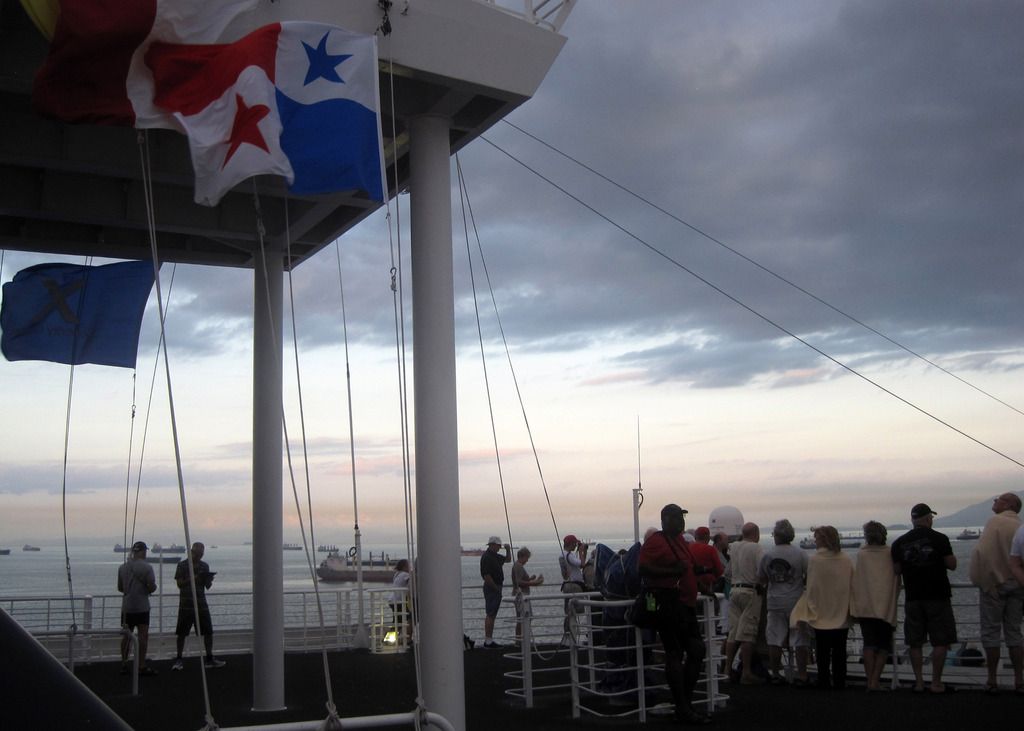
There was lots of movement around the ship as people went from side to side taking photographs.
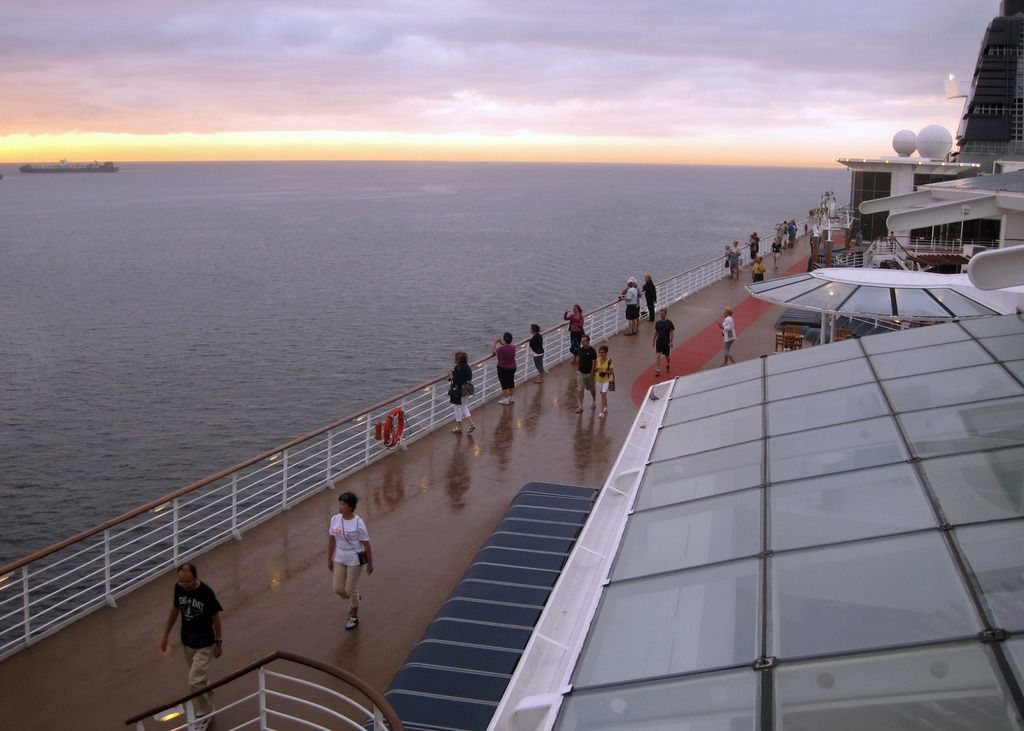
Others had gotten up early to get ready for a different sort of day.
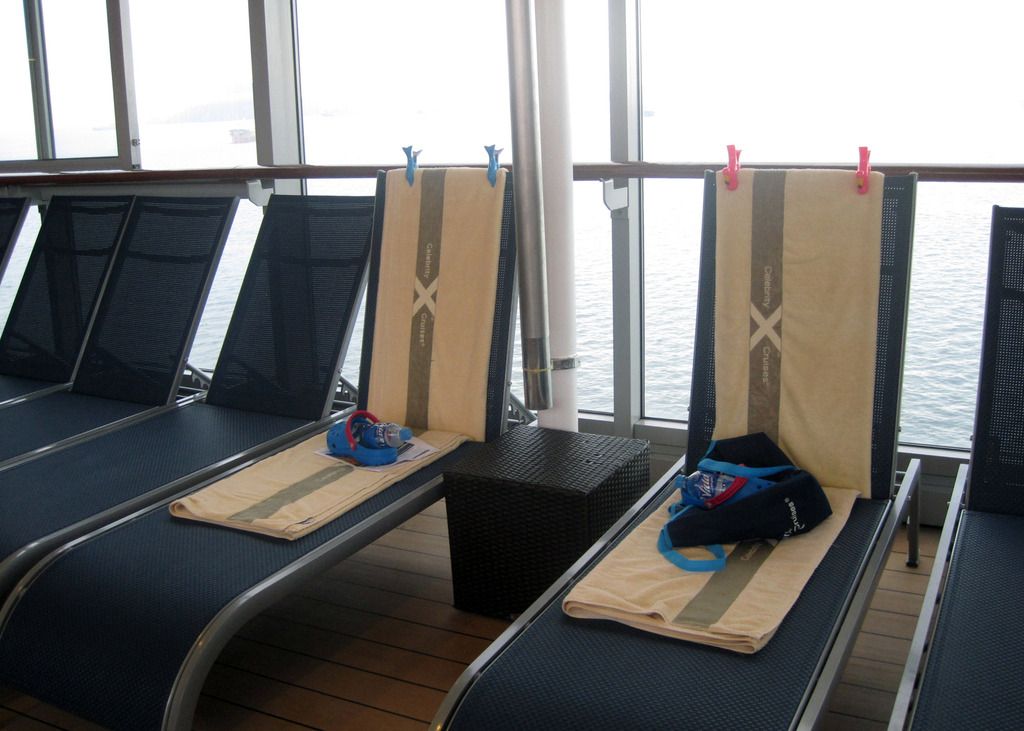
-
A few more thoughts on Manta. . . .
A hearty "Thank You" goes to my tour members for their support and cooperation. One member volunteered to help me manage the tour (which allowed me to expand its size) and gave me several excellent suggestions. Everyone on the tour arrived at our meeting place on time and well-prepared, resulting in a smooth start to a great day.
Manta is located at 0.95° South Latitude. Being so close to the Equator means that protection from the sun is essential. In addition to a hat and sunscreen, I brought a travel parasol for some instant shade. Others in our party wore lightweight, long-sleeved cotton garments.
The price of a Montechristi hat can vary greatly, depending on quality. Hats that are finely woven (the number of rows of weave per inch), have a consistent, even weave, and a consistent, even color command higher prices. We saw some hats in the vendor area of the museum for $20; hats in the sombrero shop started at $40 and went up to several hundred dollars. Hats of the highest quality can cost thousands.
My new hat does a great job protecting me from the Florida sun and since it breathes, it keeps me a little cooler.
Several hours after leaving Manta, we crossed the Equator and entered the Northern Hemisphere.
-
We were also on this cruise, which was actually the final segment of a B2B2B on the Infinity. Always fun to see someone else's photos from the same cruise.
We also had a private tour arranged in Lima and had made a partial payment. We did not have any problems obtaining a refund from that company, but some friends, who were also scheduled for a private tour in Lima but with a different tour company, are having problems.
Hi Northern Aurora, it's good to see your post. Thanks for the information on your tour provider in Lima.
-
After lunch we went to meet the maker of the finest "Panama" hats in Ecuador. Our guides told us that what came to be known as the "Panama Hat" was actually of Ecuadorian origin. It acquired the name "Panama Hat" after one was given to President Teddy Roosevelt to protect him from the sun during his visit to Panama.
We entered the home of the hat weaver to watch him at work. His hands moved so fast and the strands were so fine that some appear blurred in the photo below. He was weaving bent over, with his chest resting on a cushion that was resting on the crown of the hat which, in turn, was supported underneath by some sort of form. Working like this, he was capable of producing two hats per year for which he was paid well, by Ecuadorian standards.
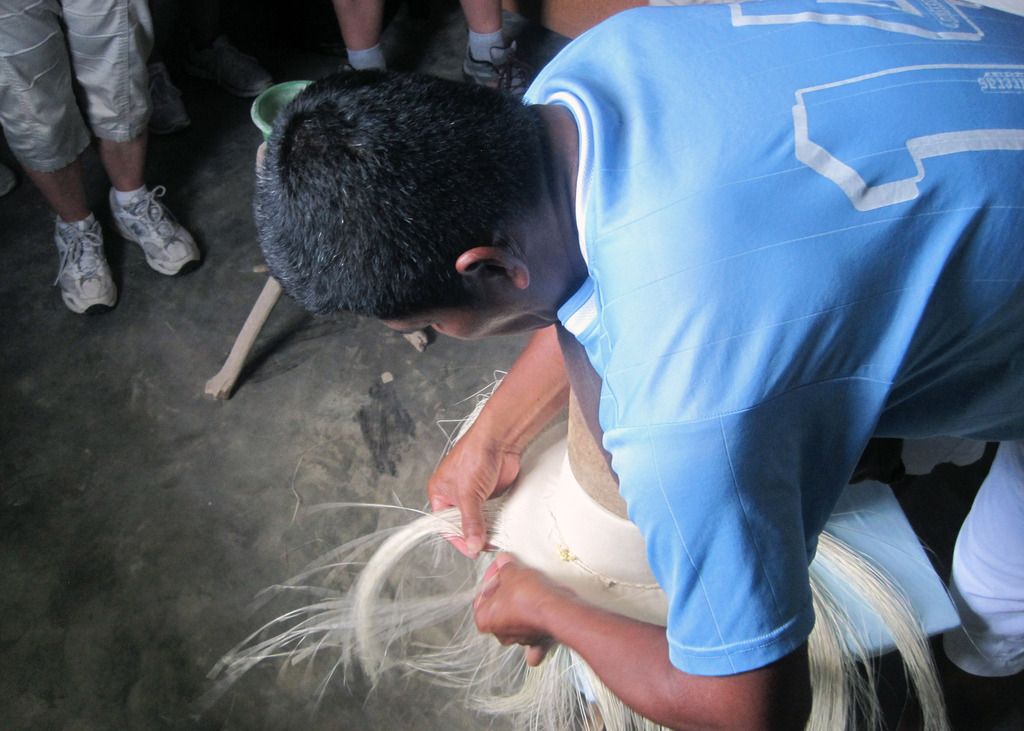
After weaving for five minutes or so, he straightened up and began to answer questions. He was very patient and seemed willing to answer our questions all afternoon, if need be. At one point he opened a cupboard and showed us one of his finished hats. He seemed more than willing to have us touch it, hold it or even try it on. Imagine! He was holding six-months-worth of income in a room full of strangers and allowing us to touch it. A few of us reached out and gingerly touched the hat, but no one seemed willing to try it on.
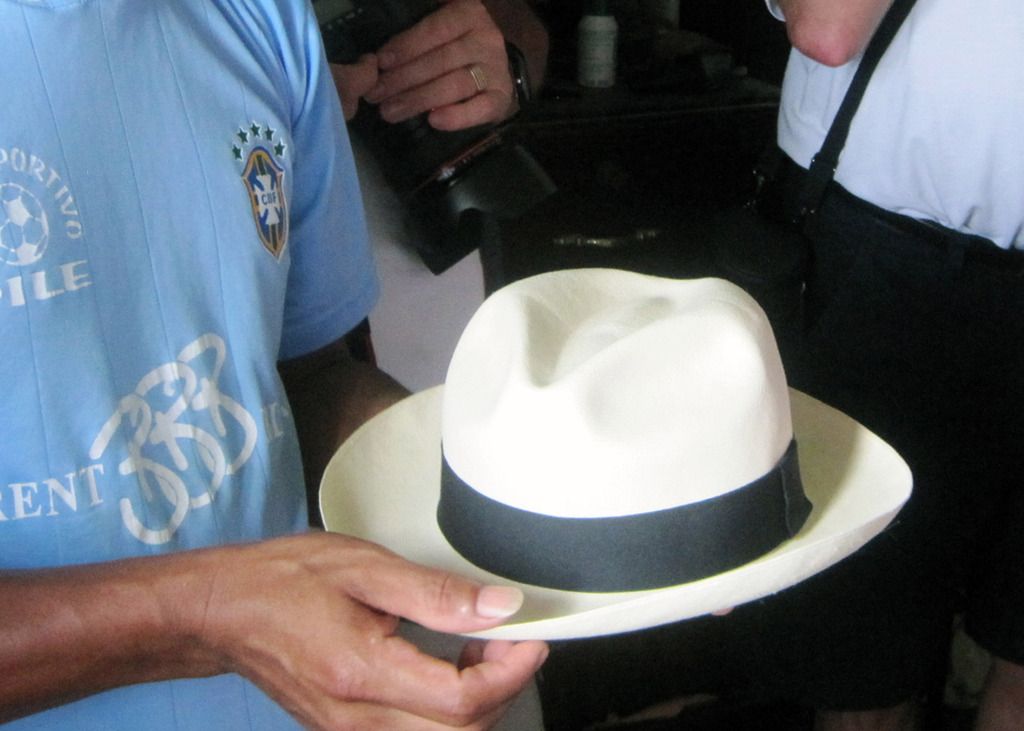
Our next stop was Montechristi, the town where the hats were traditionally woven. We stopped to see the mausoleum of Eloy Alfaro, an important figure in the history of Ecuador. (I found the mausoleum to be quite beautiful.) There was also a museum and several small shops selling handicrafts at the site.

Our last stop was a hat shop where we had the opportunity to purchase authentic Montechristi hats of our own. About half of us piled off the bus and up the steps to the shop. I had warned ComputerTravelGuy for weeks that I wanted a traditional hat and several conversations later, he had reluctantly agreed. Over the course of the day, however, he had become an enthusiastic connoisseur and now wanted a hat of his very own.
All around us we could see people trying on hats. There was really quite an excellent selection (at all different price points) and I was having as much fun watching others pick out hats as I was picking out my own. ComputerTravelGuy and I both chose the classic style. ComputerTravelGuy dickered a little and before we knew it, we were the proud owners of two traditional Panama, er, Montechristi hats.
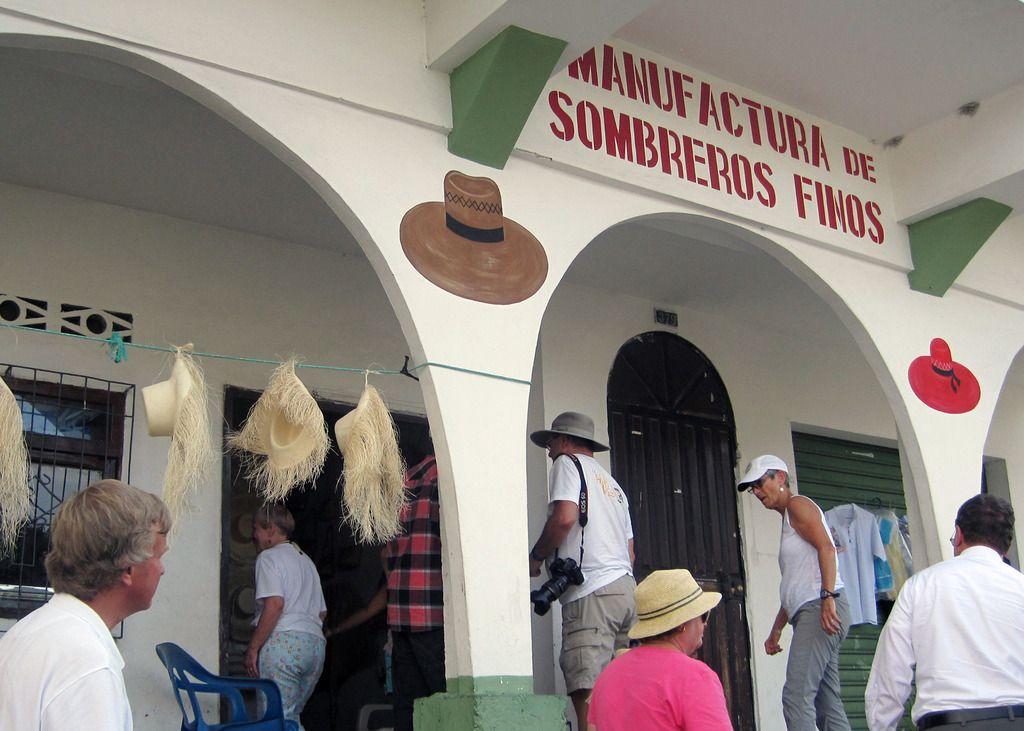
We piled back on the bus with our purchases adorning our heads. On our way out of Montechristi, we passed a statue commemorating the town's history of weaving fine hats.
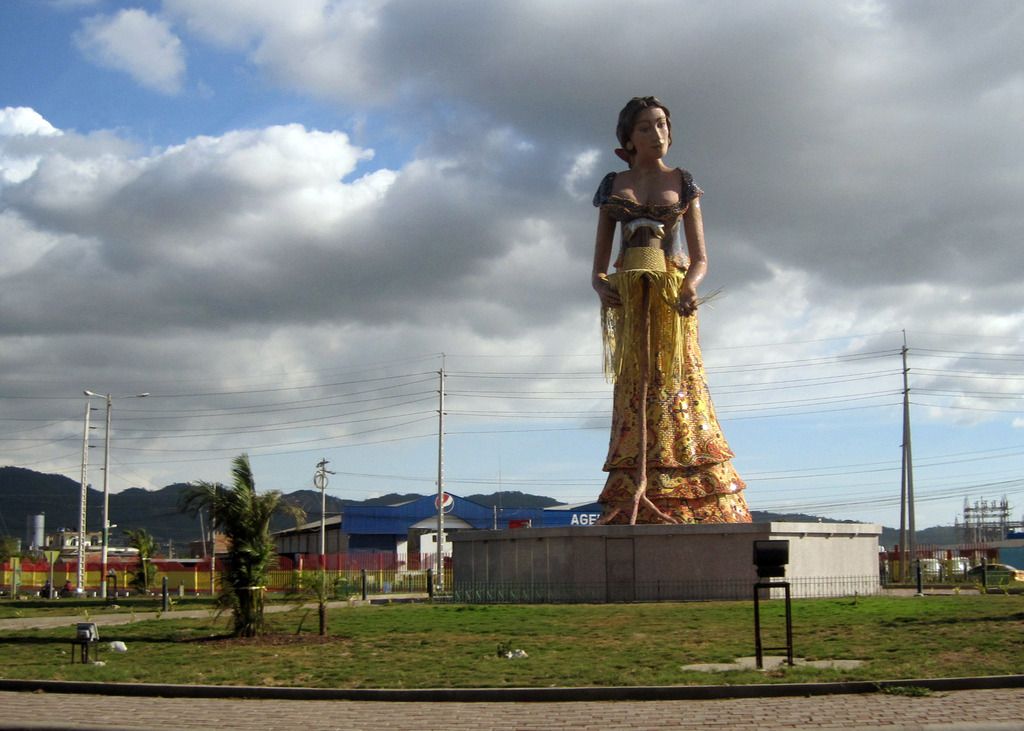
After leaving Montechristi, we had about a 30-40 minute ride back to the port. We had had a very full day. Many seemed content to watch the scenery go by. There were several quiet conversations and Jonathan and Jesús answered any last questions. Before we knew it, we were back at the port. We thanked the guides for our excellent day and piled into the port shuttle for our trip back to the ship.
As the ship pulled out of Manta, we took one last look at the port through our stateroom window. It had been a good day.
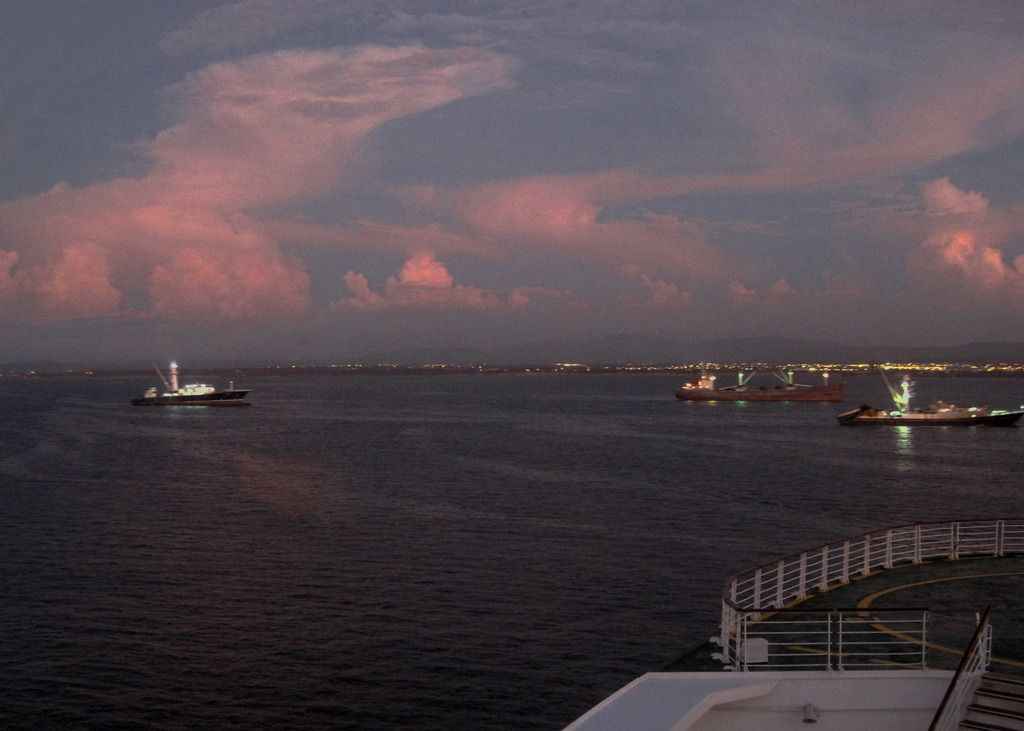
-
Looking forward to the next installment! Brings back lots of great memories, since I've done that itinerary (except that we did stop at Lima, so I didn't get to see the Islas Ballestas, which I would have loved!) Hugs to you and CTG!
Salish Sailor :)
HI!!! How have you been??? We thought a lot about you on the cruise and wished that you could have been there. (Alas, we are all at different places on our bucket list.) What a great experience we had going around The Horn in 2010!
-
We stopped for lunch at a small family-owned restaurant along the a scenic stretch of highway. Our group of 16 filled the entire second story of the restaurant.
The menu was simple, yet nourishing and the prices were quite reasonable. Jonathan and Jesús helped people translate the menus into English and made sure that those with dietary restrictions had the information they needed to make safe choices. ComputerTravelGuy and I shared a large plate of shrimp and rice ($7.00) an order of fried plantains ($2.00), and two bottles of Ecuadorian beer ($1.50 each). Our food arrived steaming hot and in generous qualities. The mountain of shrimp and rice on my plate was more than enough for the two of us and we couldn't finish the plantains. The beer was served in 600 ml bottles.
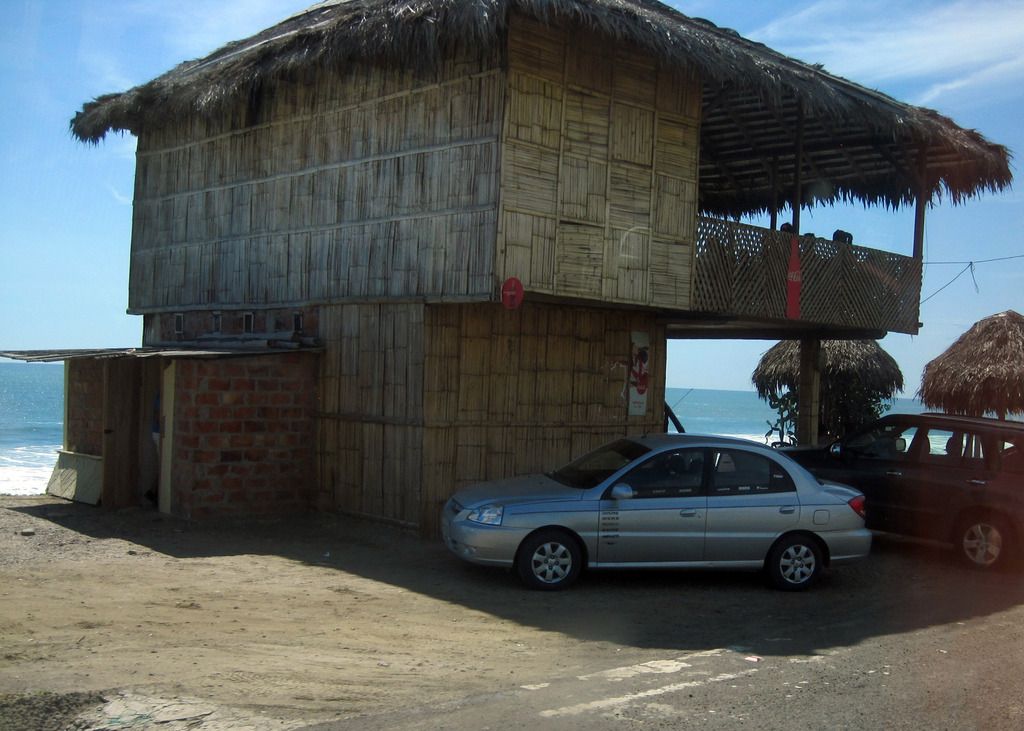
Our view from the open air balcony was beautiful.
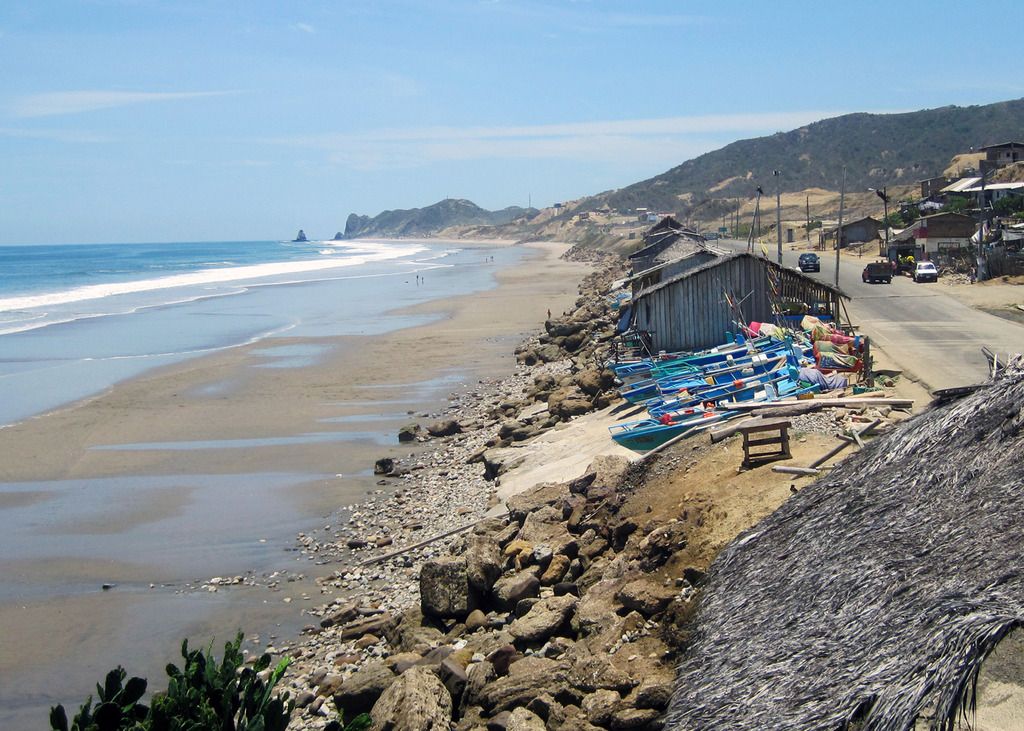
We could see Ecuadorian families spending a lazy Sunday afternoon on the beach.
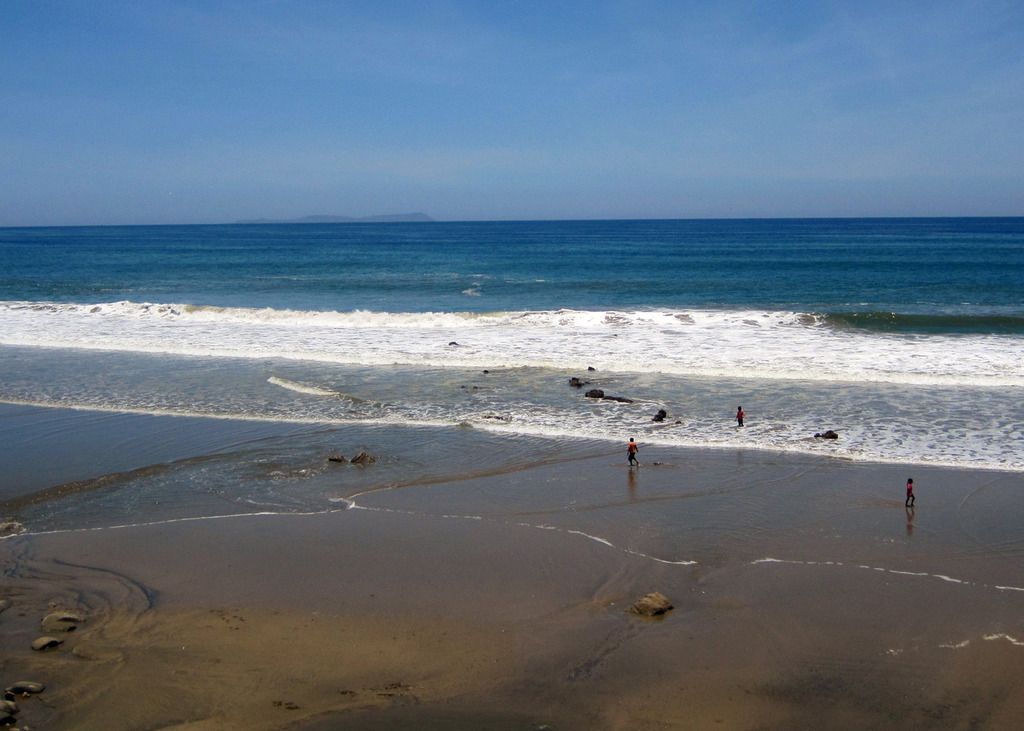
These homes, across the street from the restaurant, all had a spectacular view of the Pacific Ocean.
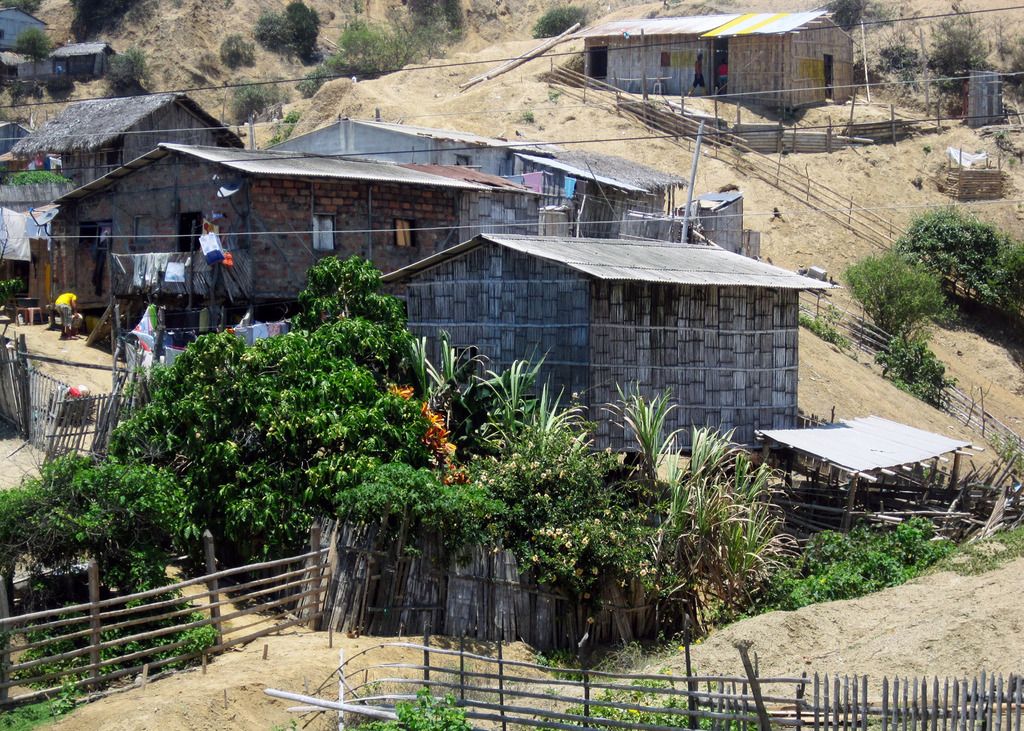
-
After another day at sea, we arrived in Manta around 10 AM on Sunday, March 22nd. This morning we were able to awaken slowly and eat a leisurely breakfast in the main dining room. For the port of Manta, I had chosen to sponsor a private tour for some of my fellow roll call members. I returned to our stateroom after breakfast to look over the documentation before heading down to our group’s meeting place.
Our tour provider was Narwell Ecotours, a small Manta-based company committed to providing “experiences that allow you to unite with the environment around you, be aware of nature and its inhabitants”. (From their website.) Elsa, my point of contact, had always responded to my emails promptly in clear, correct English. Since our itinerary change had affected our arrival time in Manta, I had emailed Elsa a few weeks earlier to let her know that we would be arriving an hour later. Elsa had taken the news in stride and had responded by suggesting a couple of possible ways that our tour could be modified to allow for the shortened time in port.
I had asked the group to meet in the Rendez Vous Lounge at 9:45 AM so that we could disembark the ship together as soon as it was cleared. After leaving the ship we boarded the port shuttle for a short ride to the port gates. We got off the bus and headed towards a parking lot where the private tour providers were parked. Along the way we were asked multiple times whether we needed taxis or private tour services. A polite “No, thank you” or “We're looking for Narwell Tours” was usually all it took for us to be left alone. We boarded our minibus and met our guides, Jonathan and Jesús.
Our first stop was the Pacoche Humid Forest for a guided nature walk. Before exiting the minibus, we applied sunscreen and insect repellent. We grabbed our hats and cameras and followed our guides into the forest.

A highlight for everyone was seeing the howler monkeys in the trees.
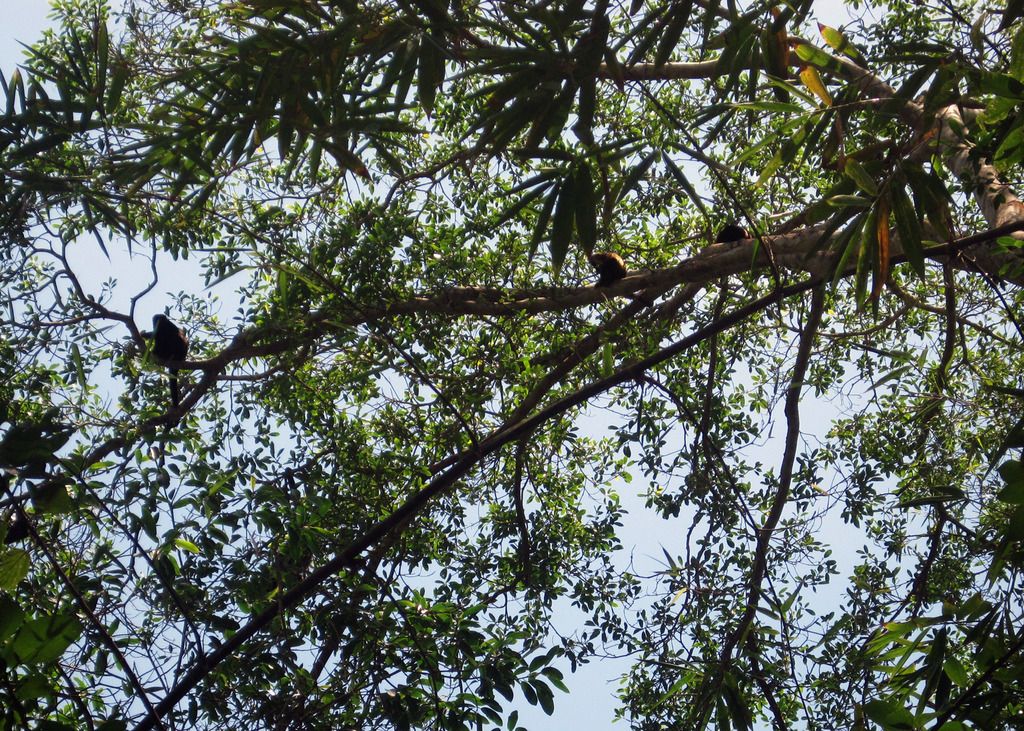
On our way back to the bus, we crossed this bridge. One of our guides went ahead of the group while the other stayed behind to make sure that everyone was okay.

-
Lima. . . .sigh.
As I mentioned earlier, our itinerary had originally included a stop in Lima, Peru. We were scheduled to arrive in the port of Callao at 7:00 AM and depart at 4:30 PM. Two weeks before embarkation we were notified that our port call in Lima had been replaced with the port call in San Martín. As you will recall from my earlier posts, we went on to have a great day in San Martín, but at the time, we were heartbroken. As far as we were concerned, Lima was "the jewel in the crown" of this itinerary.
I had booked a 12-person private culinary tour with The Lima Gourmet Company, a very highly-rated tour provider on Trip Advisor. (I checked just now and they are currently #1. I'm not at all surprised.) The Lima culinary tour would introduce us to the city of Lima through its cuisine. Our stops would include a coffee roastery, a local market, a class where a chef would teach us to make ceviche and pisco sours, and lunch at a restaurant amid Pre-Incan ruins. Along the way, a guide would point out the sights of Lima.
Samantha, my point of contact, was an absolute pleasure to work with. She always responded to my emails within 24 hours in polite, personable English. The Lima Gourmet Company’s usual policy was for tours to be prepaid up front. For my tour we agreed that, since I was reserving the tour almost a full year in advance, I would pay for one seat (as a deposit) to reserve the tour and the payment for the other seats would not be due until much closer to the tour date. All payments would be made via a secure website in the US.
I asked Samantha about her cancellation policy in the event of an itinerary change. She said that, in the event of an itinerary change, she would refund almost the full amount, keeping only what was necessary to cover her transactions costs. That sounded reasonable to me so I sent a deposit, booked the tour, and advertised it on my roll call.
Thirty days ahead of the tour date, everyone had sent payments and everything looked good. I had emailed Samantha to confirm that everything was in order; Samantha replied that they were ready for us.
When I learned the news about the itinerary change, my heart sank. As soon as I was able to confirm the change, I emailed Samantha to let her know that we would not be coming to Lima and to request that she issue the refunds. She replied almost immediately with the specifics on how the refunds would be issued and what to expect. With that information I was able to email my tour members to let them know what was happening (six tour members were already on the ship) and I asked them to let me know if they did not receive notification of the refunds. Several days later, I had received both my notification and refund. Between emails and personal contact (at the Connections Party), I was later able to determine that everyone on my tour had received their notifications as well.
There had been other private tours for Lima that were organized through our roll call besides mine. I learned from others at the Connections Party that there had been some challenges in getting refunds issued. I did not learn the names of the other tour provider(s) or any specific details.
-
We are taking your trip in reverse in December. Your narrative about your day in Arica was wonderfully informative. Thanks for taking the time and effort to write
Hi JJSAsail, This was a very nice itinerary. We liked the way that the port calls alternated with sea days. I'm pleased you found my Arica information to be useful and I hope that you find my upcoming posts on the ports of Manta, Colon, and Cartagena to be of benefit as well. I would be happy to answer any questions.
-
A few more thoughts on our day in San Martín. . . .
As I’ve said earlier, we loved our trip to the Islas Ballestas and we had a magical day. What I haven’t mentioned yet is the not-so-magical smell that was hard to ignore. The guano from lots of fish-eating birds, combined with the smell of excreta from lots of fish-eating sea lions, made for a rather pungent odor.
We were encouraged to bring a hat, sunglasses, and sunscreen on this tour. I almost donated my favorite ball cap to King Neptune twice that day, thanks to the wind, so consider bringing a hat that won’t blow off in the wind.
I thought Celebrity did a remarkable job of arranging shore excursions for this port on very short notice. In addition to the excursion we took, the other offerings included excursions to the Incan ruins at Tambo Colorado, the Paracas National Reserve, a Pisco Valley tour that included 2 bodegas, and the Nazca Lines overflight.
I heard very little feedback about the other excursions. One person said that he had not been impressed with the bus trip to Paracas National Reserve. On the other hand, I spoke to a couple who had paid almost $500pp to take the Nazca Lines overflight and were thrilled with the experience. They said that they had always wanted to see the Nazca Lines and were unsure of whether they’d ever come back to Peru.
There may be some potential for private tour providers for this port. Before deciding to throw in the towel and take an excursion through the ship, I spent a quality 10 minutes searching for private tour providers. I did find some interesting results that I might have pursued had there been more time. One of our roll call members advertised a tour for this port, but I didn’t hear how it turned out.

Valparaiso to Fort Lauderdale aboard the Celebrity Infinity: A Photo Review
in South America
Posted · Edited by polySeraph
Thanks, Allan! I'm glad you've enjoyed my review. I've had fun selecting the photos and writing the commentary. It's helped me relive the experience.